It seems we can’t find what you’re looking for. Perhaps searching can help.
Sign Up for newsletter!
Subscribe to get the latest eBook!
Hotline







eCommerce has become an essential business model that fashion brands must utilize not only to survive during the COVID-19 pandemic but also to assist companies in adapting to changing customer behavior, providing competitive advantages for future breakthroughs.
As a result, fashion eCommerce has become a crucial business trend for many fashion businesses today, from start-ups to “giant” corporations.

According to Statista, the compound annual growth rate (CAGR) of the fashion eCommerce market is predicted to be 14.2% from 2017 to 2025. The CAGR is forecast to reach a value of USD 1 trillion by 2025, in which the US market accounts for about 20%, equivalent to 204.9 billion USD.
In the Vietnamese market, fashion eCommerce is the second most important sector, just after eGrocery (The Vietnam eCommerce White Paper in 2021).
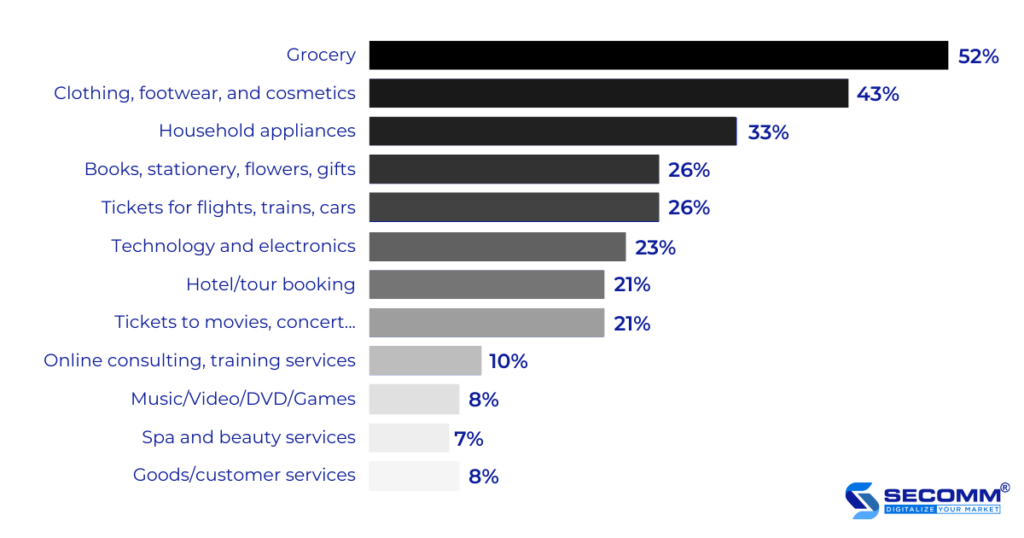
The use of eCommerce will provide fashion firms with a new sales channel, along with offline commercial activity in showrooms. For geographical factors, eCommerce transcends place and time to allow customers to purchase whenever and wherever they choose.

Simultaneously, eCommerce is a prominent avenue for reaching customers, particularly in the sphere of fast fashion for women. Marketing activities such as Livestream, Shoppertainment (Shopping with entertainment), Affiliate, and so on are more effectively carried out, leading to the extension of the commercial scope for enterprises.
Following the COVID-19 epidemic and the social distancing order, consumer behavior has shifted dramatically, with the transition from physical to online buying rising over time in all categories. In the fashion business alone, the percentage of online customers climbed from 18% to 48% in 2020–2021. As a result, it is critical for fashion businesses to implement eCommerce.
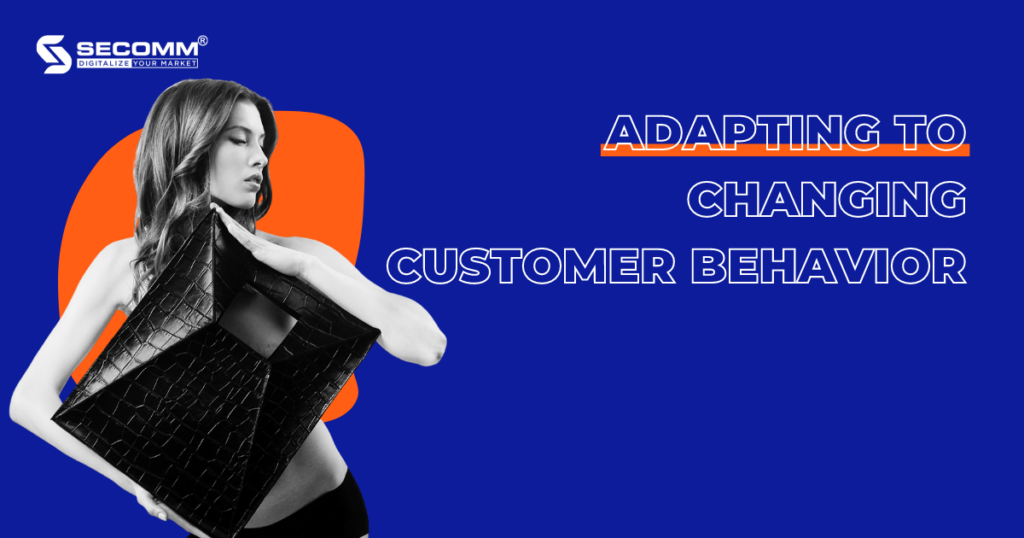
After the epidemic, consumer behavior altered drastically, such as waiting until D-Day to purchase items. Furthermore, by utilizing eCommerce technologies, organizations can follow, analyze, and synthesize the consumption behavior of each target group, something offline purchasing cannot accomplish. This ensures that businesses always have enough aggregated and forecasted data to implement business plans.
When technologies that improve user experience in e-commerce are used, customer purchases will be made faster.
Visual experiences such as photos, movies, virtual reality experiences, and so on provide customers with full product information and expertise, enabling a speedier purchasing process. VR / AR technology enables people to shop for garments, accessories, and shoes online in the same way they would in a store.
For example, the American Apparel company has used AR to show shoppers more product information, like detailed descriptions, availability, colors, and buyer reviews.

eCommerce allows businesses to tailor the experience for consumers by collecting, evaluating easily, and summarizing the consumption habits of each target group, often with the following features: Recommend products, Products seen, and so on.
eCommerce provides a seamless experience for customers across many channels such as social media (Facebook, Instagram, Tiktok, Zalo, etc), eCommerce marketplace (Shopee, Lazada, Tiki, Sendo, etc), eCommerce website, and mobile app.
Shein is a Chinese eCommerce site created in 2008 that specializes in apparel and accessories. With the motto “everyone can enjoy the beauty of fashion,” the company pushes to give consumers a diverse selection of product options. Shein is currently regarded as a fashion “empire” with a valuation of $ 100 billion – more than Zara ($ 69 billion) and H&M (23 billion) combined.

Shein focuses on the youthful client sector of Gen Y and Gen Z, who use the Internet often. As a result, this brand has used technical components to reach more consumers in an appropriate and exact manner.
Shein created an eCommerce system that included a website and a mobile app to target overseas markets such as Europe, America, Australia, and the Middle East. Shein then advocated Social Commerce, Ecommerce Marketing, Affiliate Marketing, KOC, and other tactics to improve brand awareness and engagement.
In 2021, Shein’s mobile app exceeded 7 million monthly active users in the US alone (Airnow Data), and the hashtag #Shein garnered more than 10 billion views on TikTok (Jing Daily). Revenue reached $15.7 billion in 2021, up 60% from 2020 ($9.8 billion). It can be seen that Shein is a clear example of the effective application of eCommerce to capture market share in the fashion industry.
Coolmate is a menswear startup that was established in 2019. Coolmate is a mix of the words “cool” and “mate,” which means that the brand’s major purpose is to be a fashion buddy for customers. After barely two years of operation, this company received a $500,000 funding call from Sharktank Vietnam.
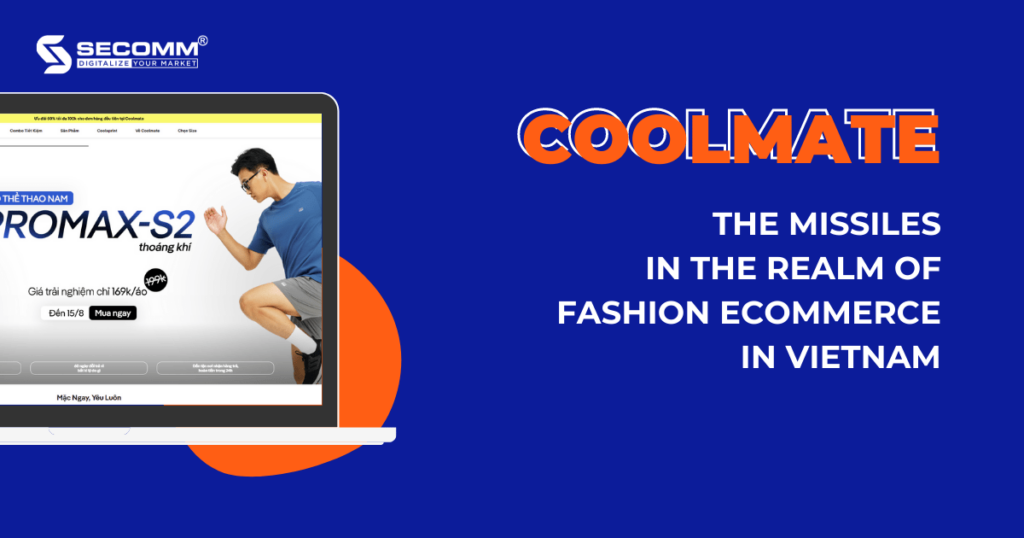
Coolmate utilizes the Direct to Customer Ecommerce (D2C eCommerce) model and concentrates on developing its own fashion website to provide a quick and cost-effective buying experience. At the same time, this brand prioritizes product quality, which is 100% made in Vietnam and meets export standards at low costs. Furthermore, to implement e-commerce faster, Coolmate advocates thoroughly apply the strategy of Ecommerce Marketing, Affiliate Marketing, Email Marketing, etc.
Aside from the $500,000 agreement for a 12.5% interest, 2.5% of the consultancy shares pledged, this fledgling business has other noteworthy statistics. Coolmate’s sales will reach VND 139 billion in 2021, up 3.5 times from 2020, with revenue expected to reach VND 440 billion in 2022 and an IPO (Initial Public Offering) by 2025. In general, eCommerce has considerably contributed to Coolmate’s development, as well as providing the groundwork for fashion businesses to follow to grow by market trends.
Yody (previously Hi5) is a family apparel label that was founded in 2014. To provide Vietnamese fashion goods made of high-quality materials to customers in various regions of Vietnam and throughout the world. Yody now employs over 700 people and has 90 outlets around Vietnam.
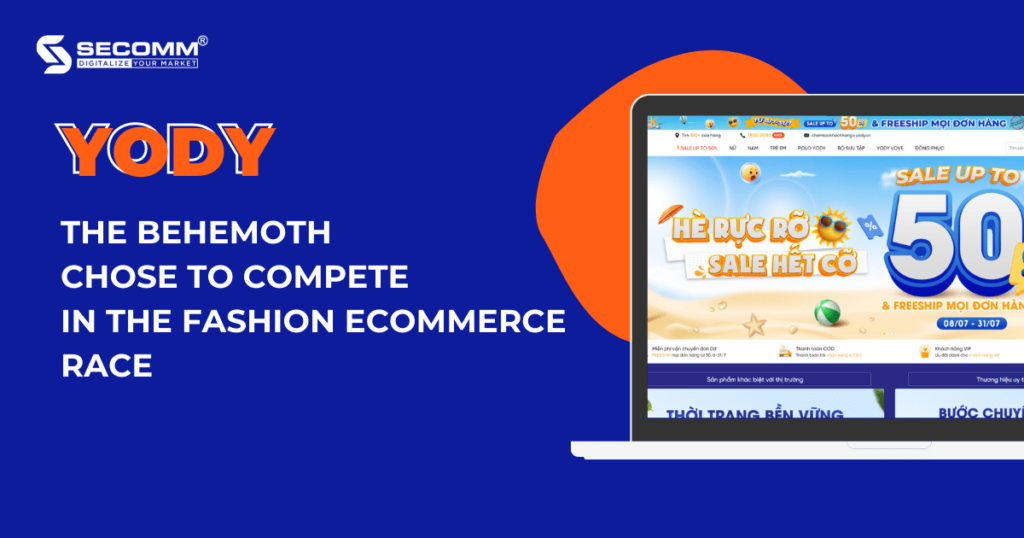
This fashion brand prioritizes the “tripod” of human resource development, product quality, and technology investment. Yody focuses on talent recruiting and culture training to engage employees in human resource development. In terms of products, Yody designs for comfort and convenience, and can be utilized in various situations, such as going to work, going out, attending meetings, and so on.
Regarding technology, Yody focuses on implementing an online sales strategy across Omni-channel such as eCommerce marketplaces, an eCommerce website, Facebook, Livestream, and so on to compete in the eCommerce race, as well as adapting to changing consumer behavior.
In 2016, Yody was selected as one of the ten outstanding young start-ups in Vietnam. By 2021, Yody’s physical sales will have dropped by 65%, but the internet segment has increased by more than 10%. Therefore, the company continues to aim to increase online revenue by 20% in the next year.
In a nutshell, how to apply fashion e-commerce will depend on the size and strategy of each company, but eCommerce is a prerequisite for successful business in this industry.
 2
2
 7,026
7,026
 1
1
 1
1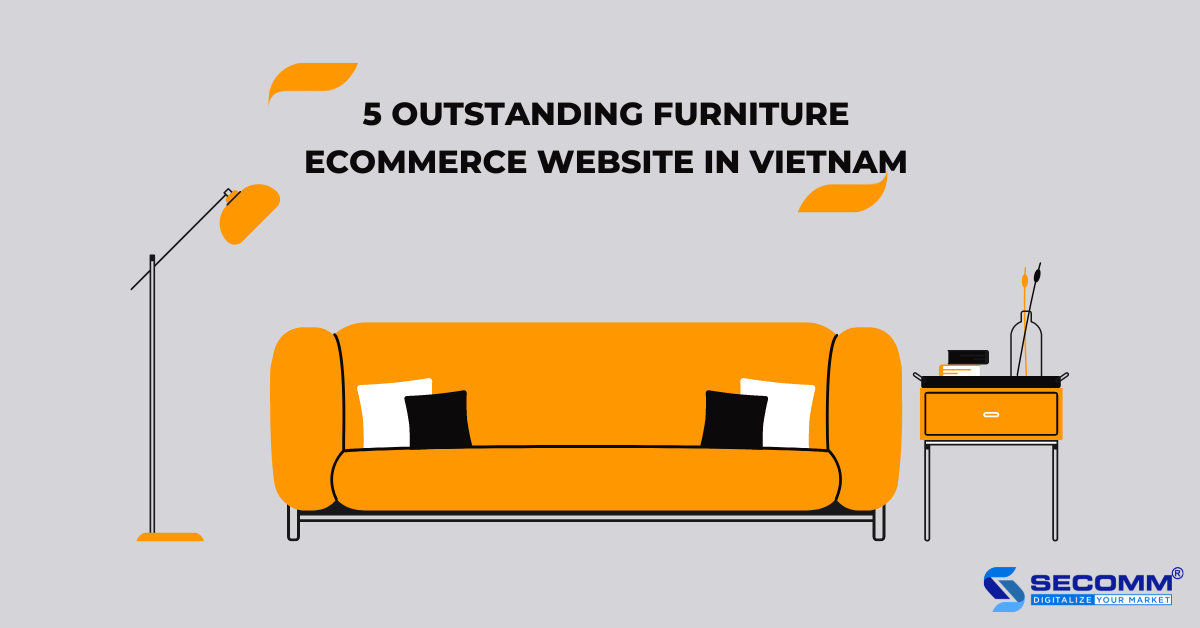
Businesses may quickly detect a change in consumer behavior throughout the course of the pandemic as online purchasing steadily expands from basic necessities like food and medicine to a variety of other industries like fashion, wine, and furniture.
Also, customers’ awareness of a pleasant, modern, and healthy lifestyle has grown dramatically, which has given the furniture business a chance to go online and serve as a catalyst for Vietnamese eCommerce furniture to see breakthrough growth.
Realizing the great potential of this field, Vietnamese furniture enterprises have been embarking on building an eCommerce website system, which is considered an important factor leading to the success of this modern business trend.
Initially founded in 2006 under the name Sieu Thi Noi That Uma, the business has only recently (in 2019) changed its name to Sieu Thi Noi That Trang Tri Baya.
Although the brand’s name has changed, its essential values haven’t. It still offers clients high-quality furniture with a clean, sophisticated, trendy design in a neutral tone, and each piece is beautiful in its own right.
Thanks to the wise investment in developing a professional eCommerce website with the Magento open-source platform with an attractive and user-friendly interface, Baya’s website currently receives more than 100,000 visits each month.
In order to give clients the best eCommerce experience, this furniture manufacturer is constantly improving the system.
In addition, the company demonstrated its awareness of market trends by creating an app called My Baya with a QR payment method and positioning it as one of the primary categories on an eCommerce website to draw consumers’ attention to the website.
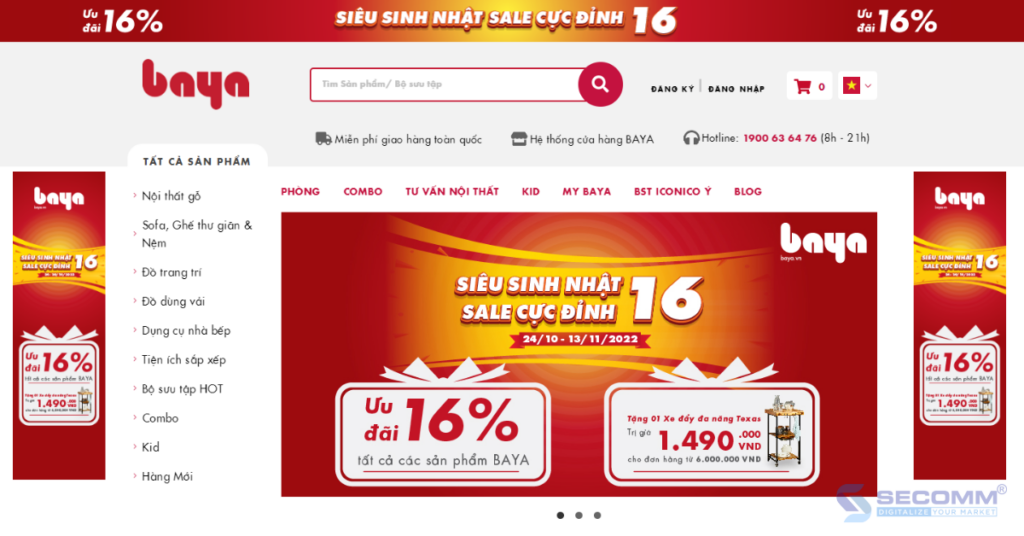
With nearly 30 years of market experience and a wide range of clients, Hoa Phat Furniture is one of the top furniture suppliers and manufacturers in Vietnam.
All of Hoa Phat’s items are designed with a contemporary, opulent, and refined aesthetic in mind. In addition to a business strategy that is flexibly adjusted to the changes in the market, the company fully exploits the potential of eCommerce by building a professional and well-organized website on the BigCommerce platform.
From there, businesses increase their coverage and brand awareness on the Internet and reach more customers thanks to effective marketing methods.
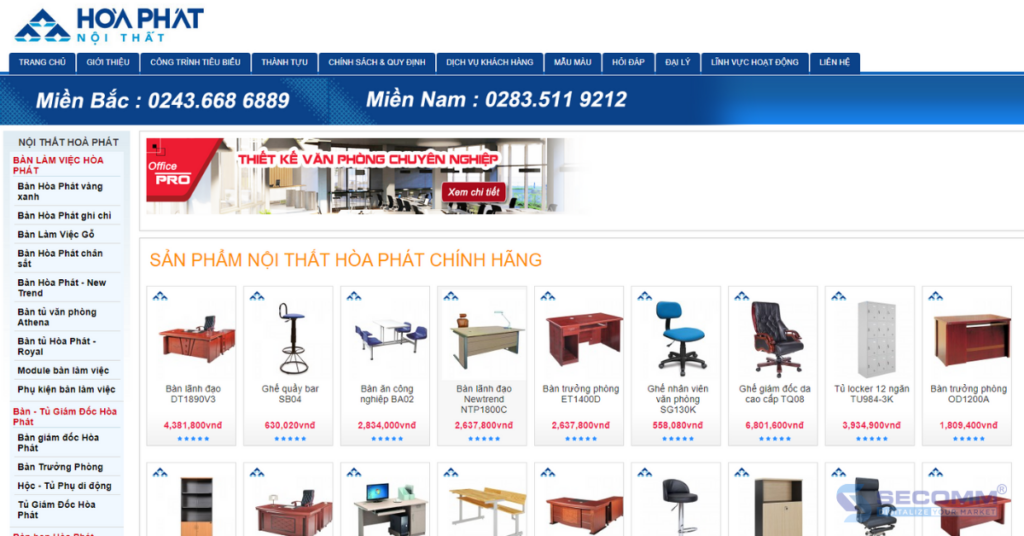
The Moho furniture brand was established in March 2020 and is a subsidiary of Savimex, a company with over 35 years of expertise in the production and export of furniture. In order to fulfill the goal of sustainable development, Moho has kept offering clients furniture goods with affordable pricing and quality in accordance with international standards.
With more than 50,000 monthly visitors and a popular Haravan platform, Moho’s eCommerce website is well-liked by customers for their online buying experience.
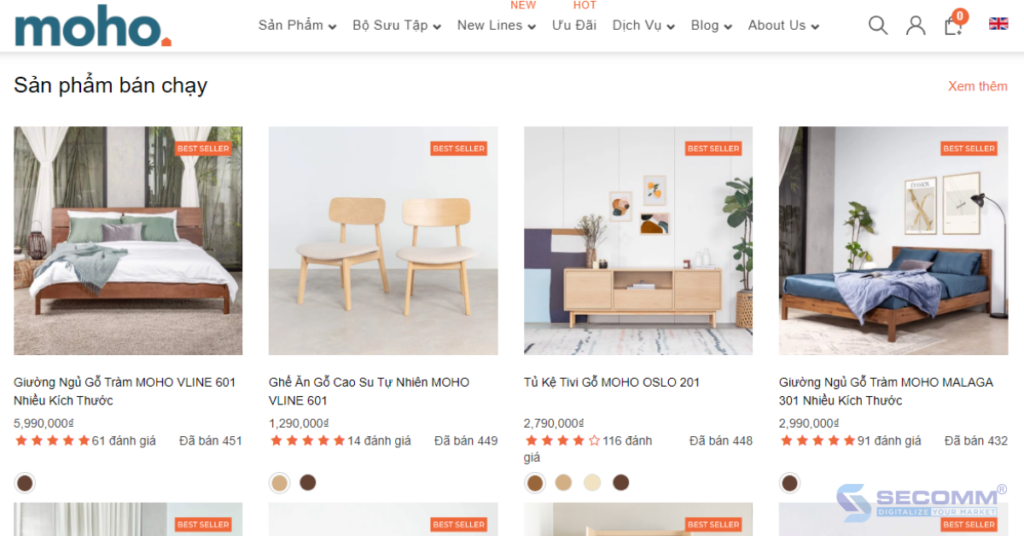
COZY is a famous furniture brand present in the market since 1995 with high-class Italian-style designs. All products distributed by COZY are subjected to quality checks. With more than 25 years of establishment and development, COZY is one of the leading prestigious units in Vietnam in importing furniture from high-end brands from Europe.
In order to increase sales channels and reach a large number of potential customers online, COZY invested in developing an eCommerce website using the Shopify platform in addition to the showroom system dispersed around the districts of Ho Chi Minh City.
Because of the website’s elegantly crafted, opulent, and smart user interface, it receives an astonishing 45,000 visitors each month.
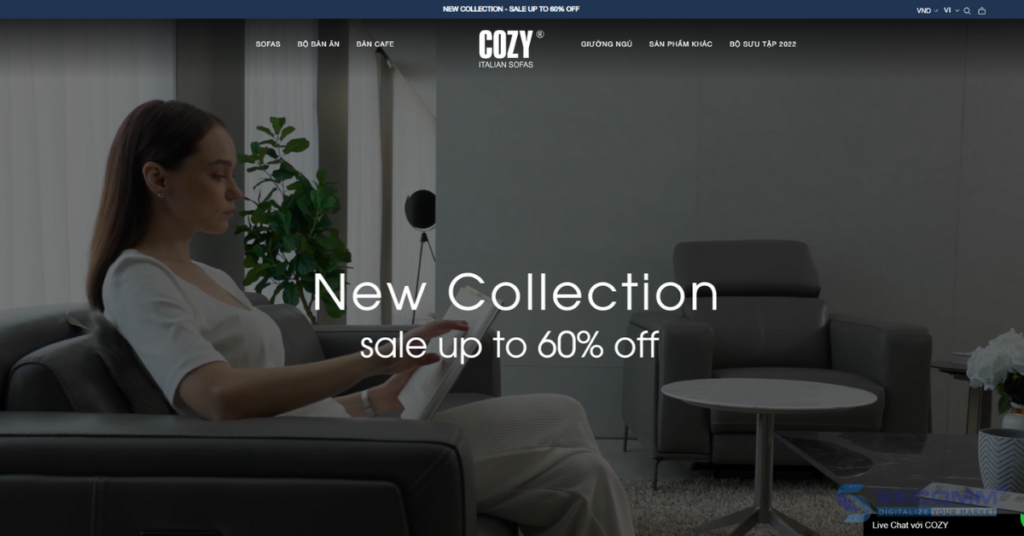
Nha Xinh chooses a simple and intimate interior design style for each of the company’s products. The WooCommerce platform’s straightforward and user-friendly design of Nha Xinh’s eCommerce website’s interface amply illustrates this.
Furthermore, Nha Xinh’s website uses 360-degree technology to enable buyers to experience the company’s interior items from a distance in an accurate manner, providing information and a complete price list for each item from every angle of the room and product.
The eCommerce website now receives more than 40,000 visitors each month because of its painstaking attention to every last detail.
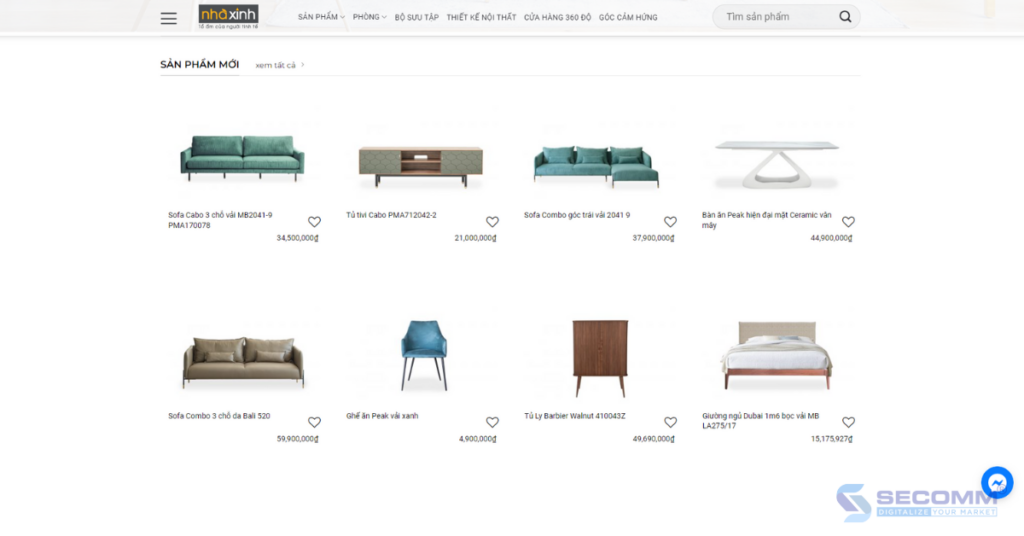
Customers can save a ton of time and money when shopping online, especially when purchasing furniture. However, there are a lot of potential hazards associated with this type of business, particularly with regard to product quality and information security, and safety during the shopping and payment processes.
The furniture eCommerce sites discussed in this blog post are well-known destinations that have been active on the market for a long time and have serviced and satiated the wide range and expanding needs of clients.
These companies demonstrate their efforts to create the technological infrastructure that will enhance customers’ online shopping experiences, and they take priority on the development of a professional, well-invested supply chain that will expedite shipments while maintaining the quality of the goods until they are received by the customer.
When Vietnamese furniture businesses launch their own fully-functional eCommerce websites, professionalism, adaptability, and speed are the key success criteria.
Nevertheless, in order for the furniture eCommerce firm to succeed, business managers must carefully and comprehensively take into account the growing client wants and the continuously shifting market trends.
In particular, the task is to lay out a solid and methodical company plan so that the best short- and long-term actions can be taken. Completing that difficult task will take a lot of time and resources. As a result, many furniture companies opt for a more straightforward approach to the issue, enlisting the assistance of a highly qualified and dependable unit.
With many years of experience in successfully implementing eCommerce for many customers in many countries, SECOMM specializes in providing consulting services with comprehensive and professional e-commerce implementation solutions. , repertoires.
Contact SECOMM today for free support and advice.
 2
2
 7,174
7,174
 0
0
 1
1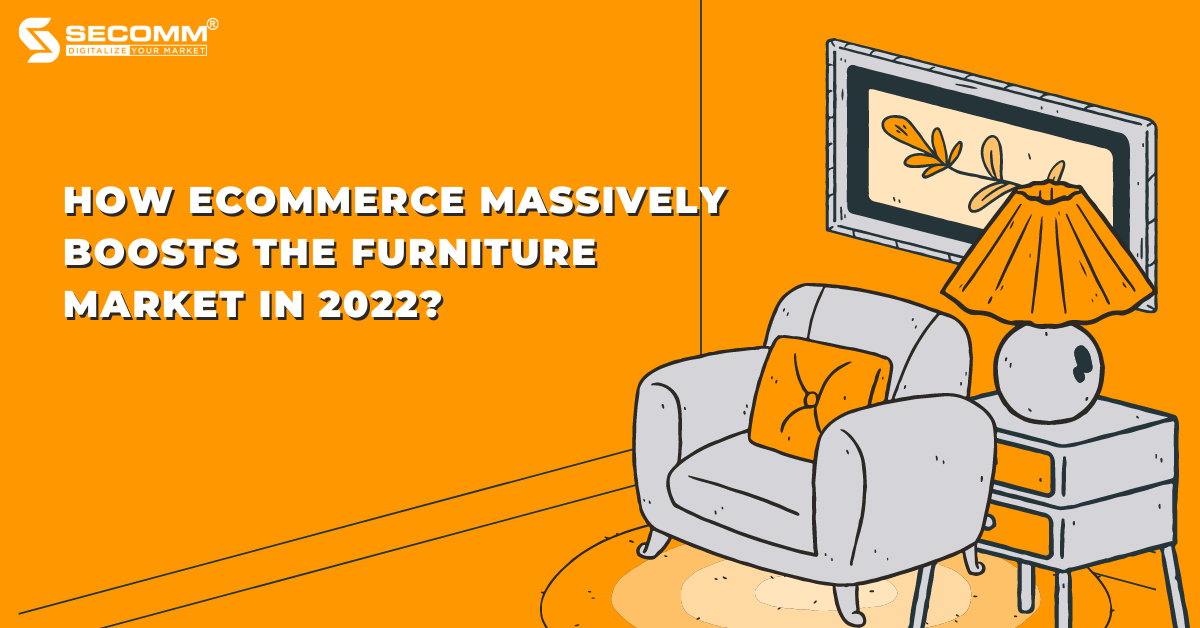
The desire for home furnishings and design among consumers has significantly increased as life gets better and better. The majority of consumers still prefer to choose and purchase products in physical stores and showrooms, but online furniture shopping is an increasing tendency. Additionally, the impact of the Covid-19 pandemic on consumer purchasing habits has changed how people purchase, which has greatly aided the development of the furniture eCommerce market.
BusinessWire estimates that the size of the furniture eCommerce market in 2021 was valued at USD 27.74 billion and that it would increase at a compound annual growth rate (CAGR) of 4.4% from 2022 to 2030 to reach USD 40.74 billion.
Recent findings made by Maddyness include the following intriguing details:
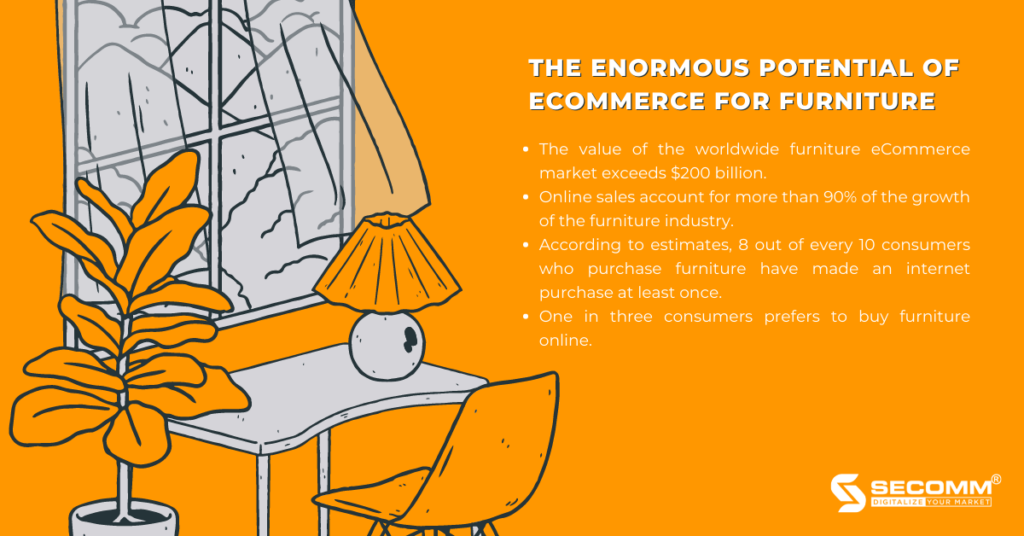
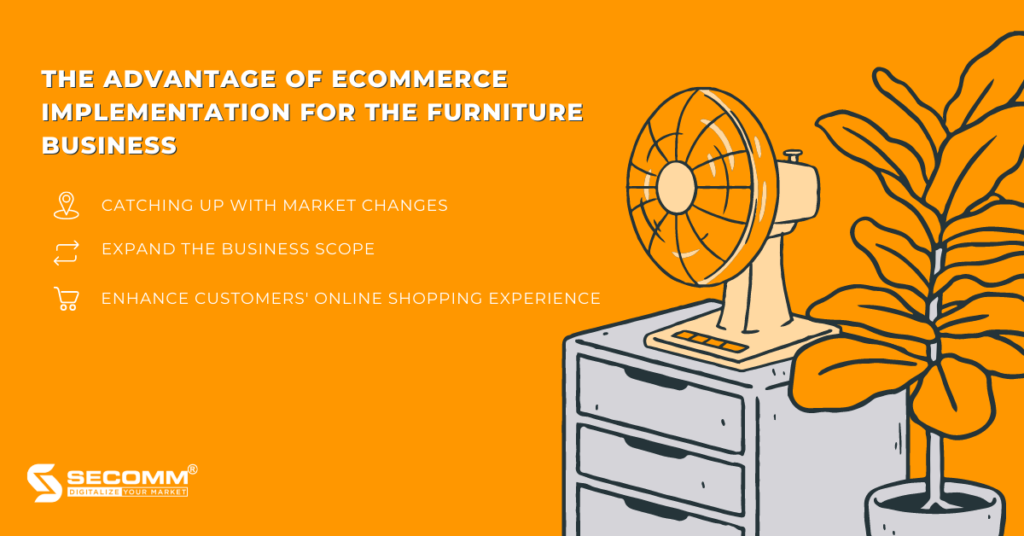
The furniture sector has experienced a significant decrease in sales over the past few pandemic years, along with many other industries.
People are compelled to reduce their social interactions during the social withdrawal period. They now spend more time working, living, entertaining, and teaching at home. In light of the unpredictable changes of the pandemic, the necessity to clean and renovate the dwelling has therefore substantially increased.
Due to limits on leaving the house, online shopping at the time had become not only a need but also an urgent method of purchasing in place of in-person purchases. That serves as the springboard that gives eCommerce its spectacular development and propels it into other industries like fashion, grocery, wine, and even furniture.
These two elements highlight the “cake’s” enormous potential and aid many furniture companies in realizing and swiftly implementing eCommerce for market revolution and sustainable development.
Due to the Internet’s rapid expansion and the burgeoning online shopping trend, which is gradually replacing traditional offline shopping, the adoption of eCommerce will benefit furniture manufacturers by providing a new sales channel and attracting a big number of potential clients (at stores, and showrooms).
eCommerce implementation will also help to broaden the market for businesses by improving the circumstances for marketing campaigns to be more successful.
When firms use technology to improve customer experience in eCommerce, furniture shopping will happen more quickly.
In the digital age, for instance, visual experiences from VR/AR technology, 3D product visualization, and 360-degree photography are very popular, gradually replacing in-store shopping while still being fully informed and realistic visualization of products, thereby increasing customer satisfaction during online shopping.
eCommerce enables businesses to quickly and effortlessly tailor the experience for customers by gathering, evaluating, and synthesizing the consumption behavior of each target group. Typically, this is done with the capabilities listed below: Products have seen, similar product recommendations, etc.
eCommerce provides clients with a seamless experience in addition to an intuitive one across a variety of channels, including social networks (Facebook, Instagram, Tiktok, Zalo, etc.), eCommerce platforms (Shopee, Lazada, Tiki, Sendo, etc.), eCommerce websites, mobile apps, etc.
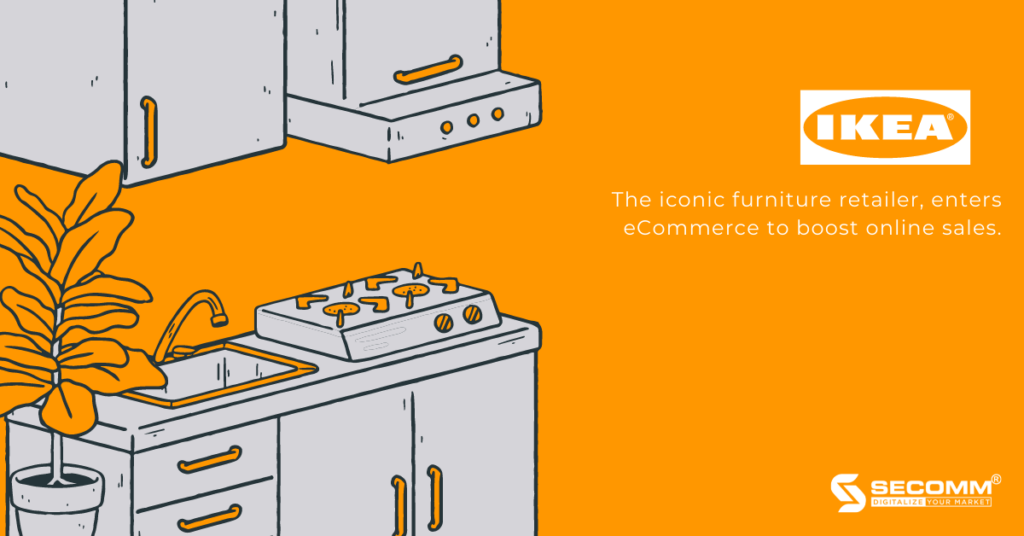
IKEA, or Ingvar Kamprad Elmtaryd Agunnaryd, is the world’s largest furniture retail enterprise and specializes in delivering minimalist-styled assembled furniture, household appliances, and accessories.
IKEA was established in 1943 in Sweden by Ingvar Kamprad, who started his business at the age of 17. IKEA swiftly gained global dominance with 392 locations across 48 nations.
With the goal of offering furniture with a lovely style and wide application while keeping the price low so that as many people as possible can purchase the goods. The majority of the departments, from marketing and sales to supply chain and warehouse, share this goal.
Everybody works together to keep IKEA’s “vital” competitive edge intact so that the company can publish catalogs with thousands of products offered at long-term stable prices.
Despite being the largest furniture retailer in the world, IKEA has lagged behind eCommerce trends, according to the Financial Times. This well-known retailer started “renovating” its sales technique only when it encountered numerous internet rivals.
The biggest barrier that makes it difficult for IKEA to adjust its previously successful business model is the maze-like arrangement of store layouts to create an engaging experience of sightseeing, interior shopping, or requiring customers to drive to the store and assemble the components to make their own furniture.
But IKEA has unimaginably succeeded in launching an e-commerce website by fusing cutting-edge technology with a well-organized marketing plan. In particular, IKEA specifically uses VR/AR technology, which is seen as a new eCommerce trend and is favored by many firms, to improve users’ online purchasing experiences.
IKEA thereby covers the sales void left by the prior on-site furniture business model, but the gap won’t truly be felt until the Covid-19 pandemic and social separation restrictions are in place.
From this point, IKEA expands its consumer base both online and offline, and sales are progressively encouraged to increase significantly.
Additionally, IKEA’s eCommerce website incorporates Instagram posts of photographs of IKEA furniture goods that consumers customize, share, and tag with the hashtag #IKEA.
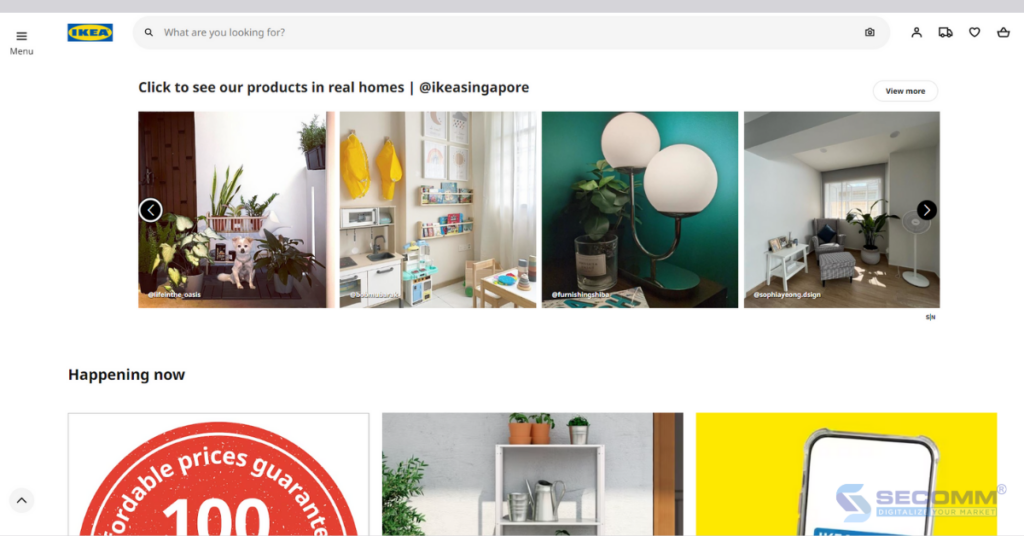
This not only helps this brand connect closely with Instagram users, increase its reputation and strengthen the loyalty of existing customers but above all, quick access to a large diverse customer base from the Internet in general and Instagram in particular thanks to the popularity and influence of this social network on young consumers.
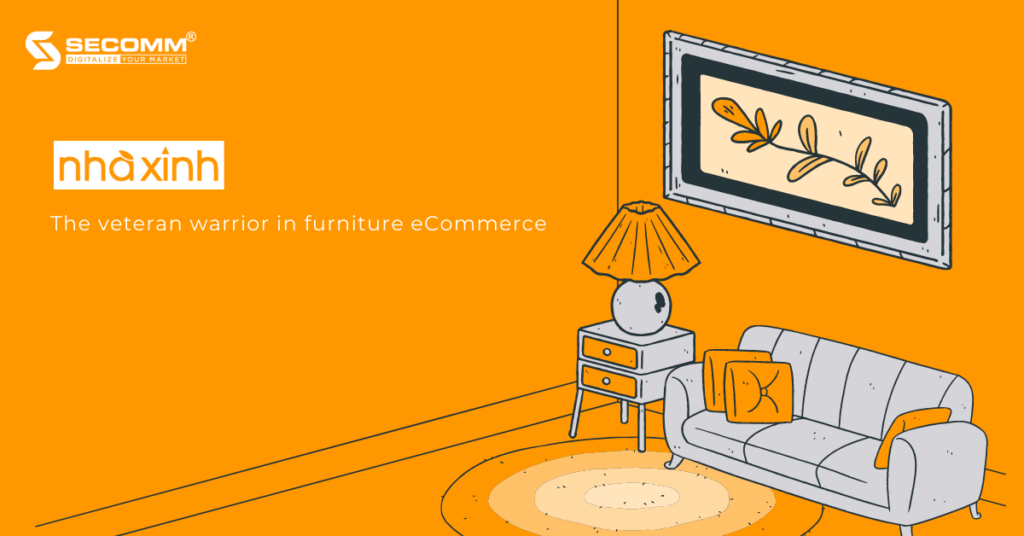
Established in 1999, Nha Xinh is a well-known furniture brand in Vietnam. It has two sizable showrooms, one each in Hanoi and Ho Chi Minh City.
As a manufacturer and supplier of living room, bedroom, dining room, and kitchen furniture with an Asian design aesthetic that favors coziness, friendliness, and simplicity above sophistication and luxury, Nha Xinh is a specialist in this field.
Nha Xinh’s website belonged to the “long-lived” row in the Vietnamese eCommerce village when it was created and launched in 2007, a period in which Vietnam was still getting used to utilizing the Internet to progressively integrate with the rest of the world.
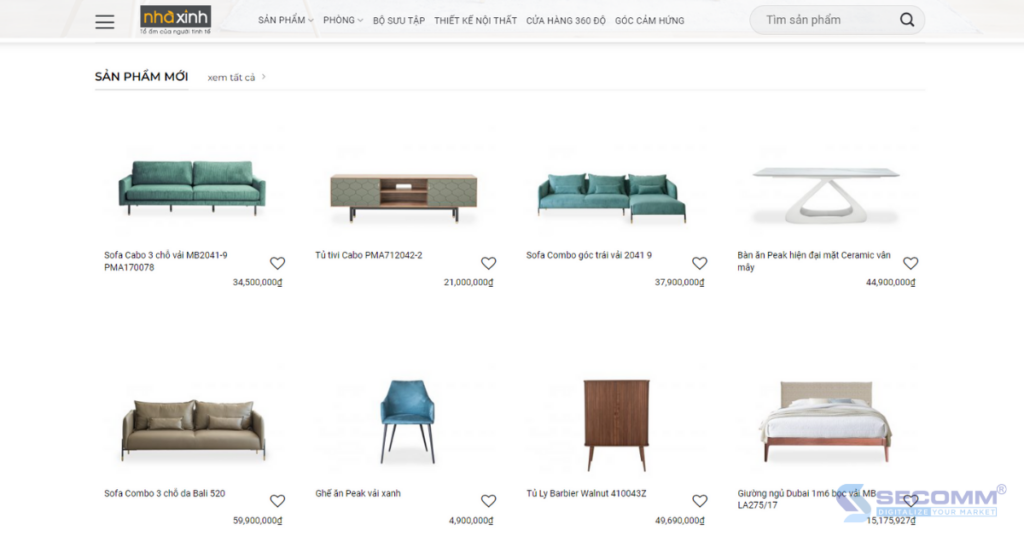
Nha Xinh’s eCommerce website has survived many years of market ups and downs while maintaining its inherent simplicity, intimacy, and sophistication.
Product categories are arranged clearly and harmoniously in each room to make it easy for customers to search, choose products that suit their needs, and get a sense of the room’s overall layout.
Customers can choose from a variety of options because the room’s layout is available with furniture and includes a detailed price. If they prefer, they can even select a combination of the interior and decor of the room without having to spend a lot of time figuring out how to combine each item because Nha Xinh already did it.
Additionally, Nha Xinh’s website has a unique section called “360-degree store” that uses 360-degree technology to let customers view the company’s interior products from a distance in an accurate manner from every nook and cranny of the room and every angle of the product, along with comprehensive information and price lists for each item.
Additionally, Nha Xinh’s “Inspiration Corner” catalog offers a wealth of thoughts and ideas to assist clients in designing their dream living space. Nha Xinh gives home design recommendations in a variety of styles, from elegant, and gentle to strong and personable depending on the individual’s preferences.
Therefore, Nha Xinh is more than just an eCommerce site that sells furniture; it is also a handbook that provides customers with never-ending design ideas.
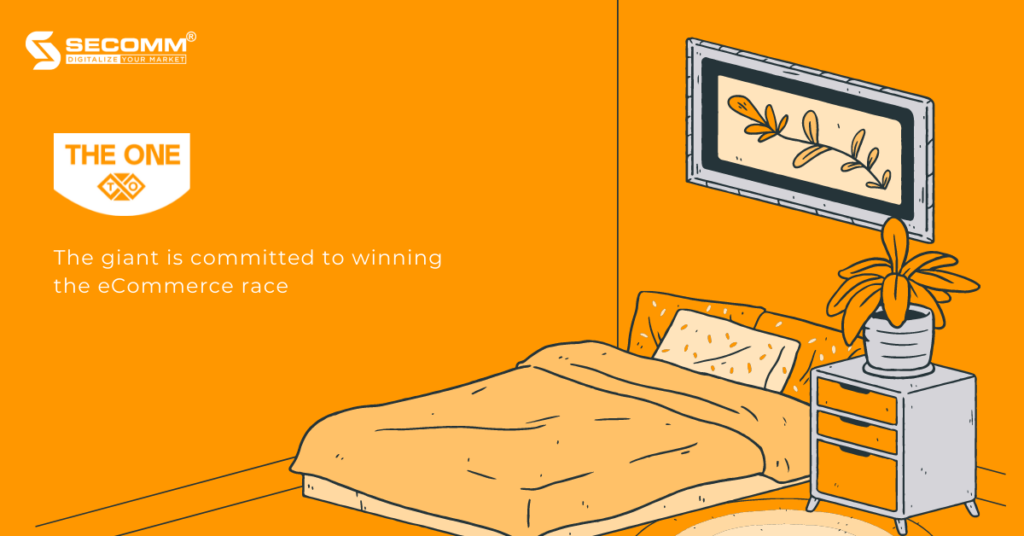
Hoa Phat Furniture was founded in 1995 and over the course of over three decades has made a positive impact on Vietnamese consumers’ perceptions of quality products and exquisite design while fulfilling a variety of needs for office furniture, home, household furniture, and medical furniture.
With a consistent growth rate of 20–25% each year, the brand is getting stronger and reaffirming its position as Vietnam’s top supplier and manufacturer of furniture.
When Hoa Phat Furniture changed its name to The One Furniture in the year 2022, it left a lasting impression on the industry. The brand name change is linked to adaptable changes in strategy. The company focuses on enhancing the stature, appearance, and image connected with the growth of the nation, helping to instill a variety of ideals into society.
Hoa Phat Furniture (now The One Furniture) invests extensively in technology infrastructure to streamline the production and supply process at the same time as it aspires to expand throughout the area and the world. One might say that The One Furniture has carried on the brand’s good core principles and improved upon them in order to better suit the current market trend.
One of Hoa Phat Furniture’s greatest successes to date is the effective use of 3D printing technology in production, which has helped the company create a number of new products like the Smart Safe; sofa and chair folding in the Italian style while also reducing production costs and speeding up prototyping and increasing product accuracy.
Hoa Phat Furniture concentrates on creating an eCommerce website to reach many potential clients that have a habit or preference for online buying, in addition to being adaptable and prompt with changes in strategy.
The firm creates websites using the WooCommerce framework, a well-known and dependable open-source platform used by many companies to implement eCommerce.
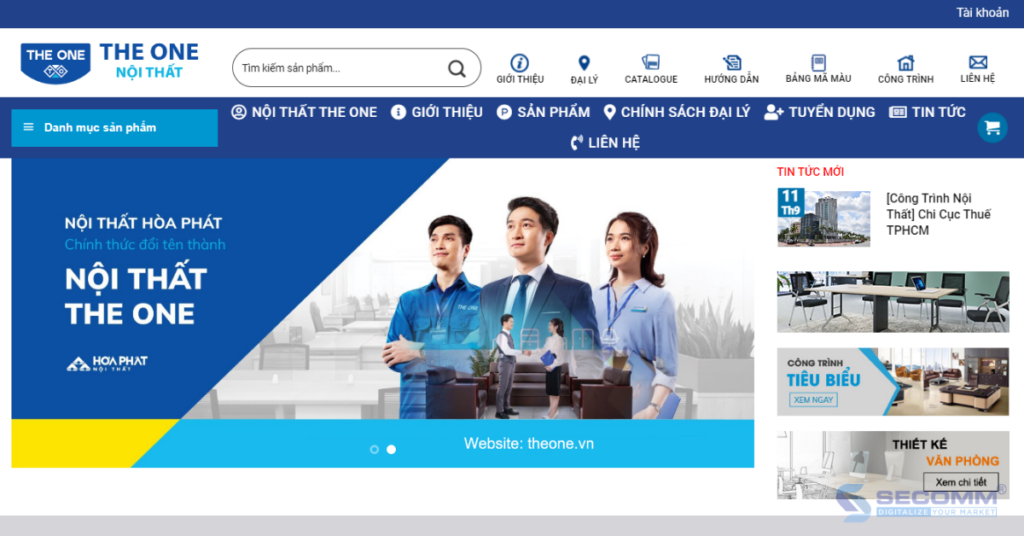
Compared to the previous version of Hoa Phat Furniture, The One Furniture’s new website (noithattheone.com.vn) features a more simplified, gorgeous, and contemporary interface (noithathoaphat.com.vn).
Additionally, the business supports the growth of well-known social media platforms like Facebook, Instagram, Youtube, and TikTok to broaden brand awareness, attract more customers, and enhance coverage.
Plus, the business offers a wide range of shipping and payment choices to accommodate the various needs of clients, making online buying at The One Furniture or Hoa Phat Furniture as convenient as it can be.
It is clear that the growth of the furniture market has been hastened by the speed at which eCommerce is developing.
Today, numerous local and international furniture companies participate in and offer the greatest shopping experiences to customers through the effective implementation of an eCommerce website, including IKEA (Sweden), Nha Xinh, and Hoa Phat Furniture (Vietnam).
From there, companies may quickly connect with a wider pool of Internet users and generate conversions through efficient marketing strategies.
However, business leaders need to carefully and comprehensively take into account the growing customer expectations and rapidly shifting market trends, not to mention specifically describe a systematic and precise business strategy for taking the most advantageous actions in the short and long term.
Completing that difficult task will take a lot of time and resources. As a result, many furniture companies opt for a more straightforward approach to the issue, enlisting the assistance of a highly qualified and dependable unit.
SECOMM has many years of expertise in effectively executing eCommerce for numerous customers in various countries. We specialize in offering free consultation services with qualified eCommerce implementation solutions.
Contact us right away for free counsel and assistance.
 2
2
 4,768
4,768
 0
0
 1
1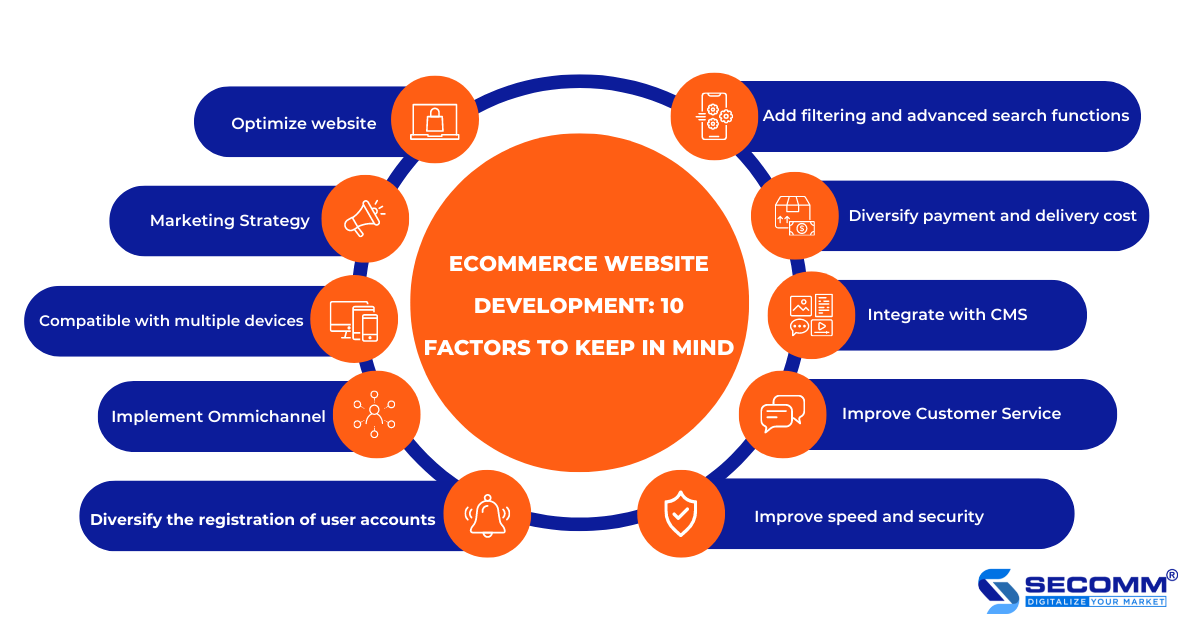
Creating an eCommerce website is a critical step in assisting businesses in spreading their brands and increasing their ability to reach potential customers on the Internet, thereby increasing revenue and profit. However, developing a business website is a complicated process with many aspects, particularly with eCommerce websites.
Businesses must consider everything from user experience to operational performance and many other aspects of the site. Here is a summary of the key factors of an eCommerce website that businesses and website developers should consider before getting started.
According to Think with Google research, if a web page takes up to 5 seconds to load, the likelihood of a user exiting increases by 90%. As a result, businesses must prioritize optimization and ensure that their eCommerce website is always operational.
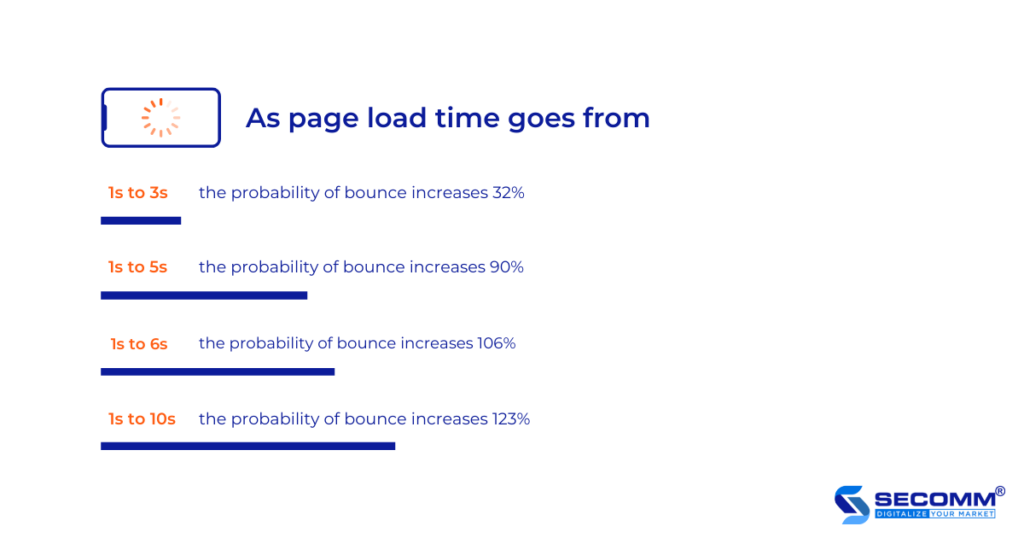
Furthermore, businesses must pay attention to optimizing SEO so that the website has the highest possible ranking on search engines using specific techniques and strategies if they want to maximize revenue on their brand websites. One of them is the strategy of incorporating keywords into the eCommerce website’s content, as well as description, title, and image information.
When adding an “alt text” description to an image, many businesses forget that customers can find their website through image search. This is also a significant flaw that results in a significant loss of potential customers.
Furthermore, in the early stages of e-commerce website deployment, businesses should consider hiring SEO experts. They can launch the website with the necessary meta tags, organize the page structure and internal links, create content strategies, design recommendations for cross-device-friendly functionality, improve page load speed, and many other critical aspects.
A good marketing strategy may benefit the first orders offline and online, particularly in eCommerce. Creating an early marketing strategy assists businesses in identifying the features that must be included in developing eCommerce systems.
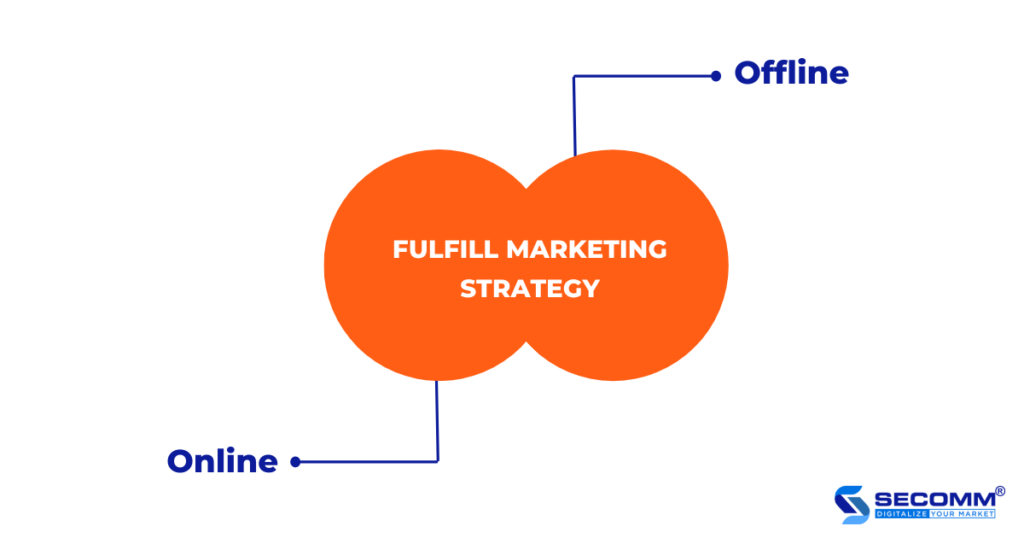
For example, when businesses want to add the option to share a promotion campaign to social networks or push notifications on mobile apps from an eCommerce website, it will be more effective if this is part of the Marketing strategy and is planned to be implemented during the development of the eCommerce website rather than proposed to be developed after the website has been launched.
According to the World Bank, two-thirds of adults worldwide use digital payments, with this figure expected to rise from 35% in 2014 to 57% by 2021. Although users prefer to make purchases via mobile apps, businesses can still increase conversions if the eCommerce interface is easily adaptable to the mobile web.
For example, after releasing a more optimized responsive design, Walmart Canada successfully increased website conversions by 20% and improved mobile order growth by 98%.
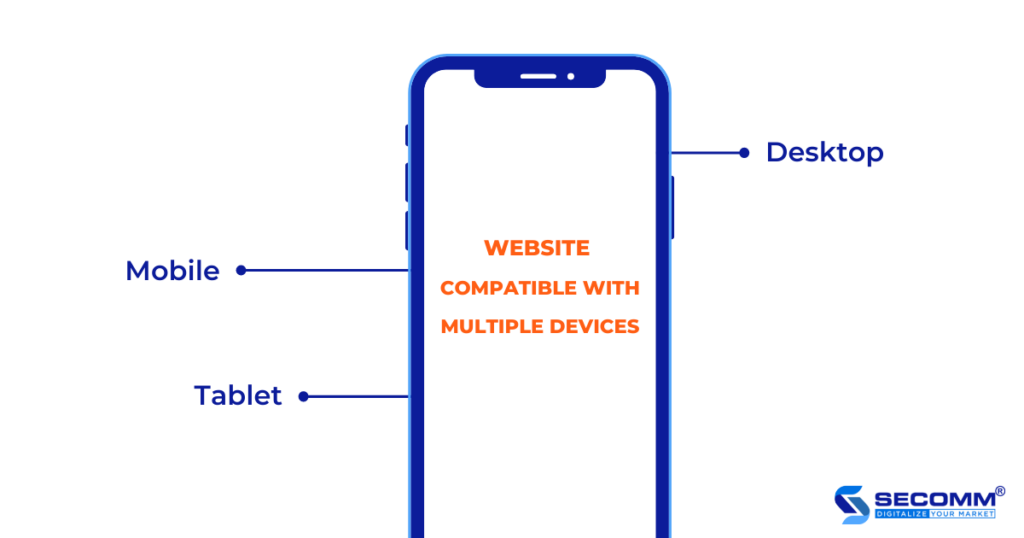
Furthermore, businesses must ensure that customers from all over the world can easily access and shop on their eCommerce website using any available browser.
As a result, businesses will conduct cross-browser testing using Google Chrome, Internet Explorer, Firefox, Opera, Safari, and other browsers to find and fix errors, ensuring customers have a great shopping experience on your website using any browser, any device, and anywhere. Businesses can hire a qualified third party to assist them, or they can conduct their own testing using a few available help tools.
In the digital age, “Omnichannel” is becoming increasingly popular and is an essential communication strategy between businesses and their customers. Every business should adopt an omnichannel strategy to connect with customers, increase traffic, drive sales, and survive the changes of the times.
As a result, implementing Omnichannel enables businesses to synchronize all sales channels for easier data management and increased eCommerce business efficiency. At the same time, Omnichannel provides customers with a seamless experience, allowing businesses to sell omnichannel and increase conversion rates.
When implementing Omnichannel, businesses can use Omnichannel platforms and systems (ETP Group, NEF, GoSELL) or choose one system as the data center for the entire system, such as an eCommerce system (Magento), ERP (Odoo, SAP).
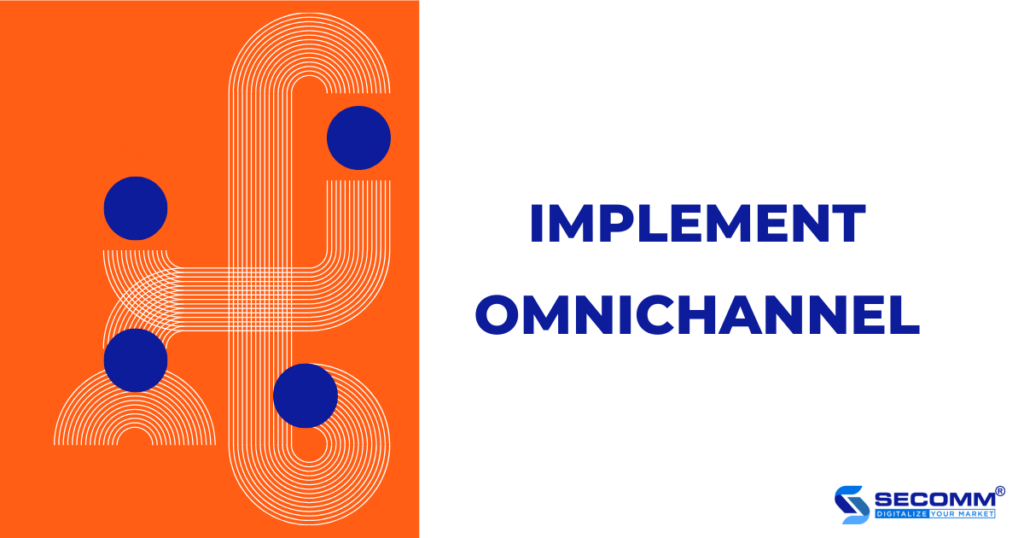
Omnichannel implementation process:
Most eCommerce websites require customers to create an account before making a purchase. This allows businesses to store the customer’s purchase history, delivery address for demographic analysis, purchase behavior assessment, sales analysis, and incentive to buy next time through Marketing campaigns.
Regular customers, in particular, will be willing to do this to reap the benefits of having an account on the website, such as quickly saving information for the next purchase or receiving notifications about upcoming big promotions. However, not all customers want to register for an account to purchase products.
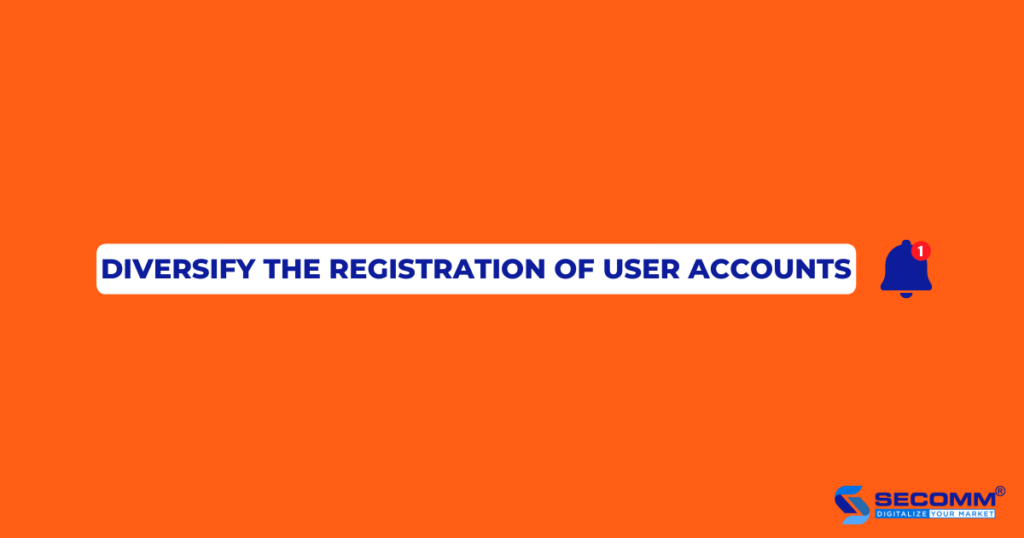
Therefore, businesses must provide options for customers who want to buy goods without registering an account, such as requiring customers to log in with a social network account or fill out a small payment form with their name, email, phone number, and address to complete the purchase process.
The eCommerce website system will automatically create an account and submit guest email login information in both cases.
Even on websites that do not sell anything, users frequently use the search bar. For businesses with eCommerce websites, the search bar must provide advanced search functionality.
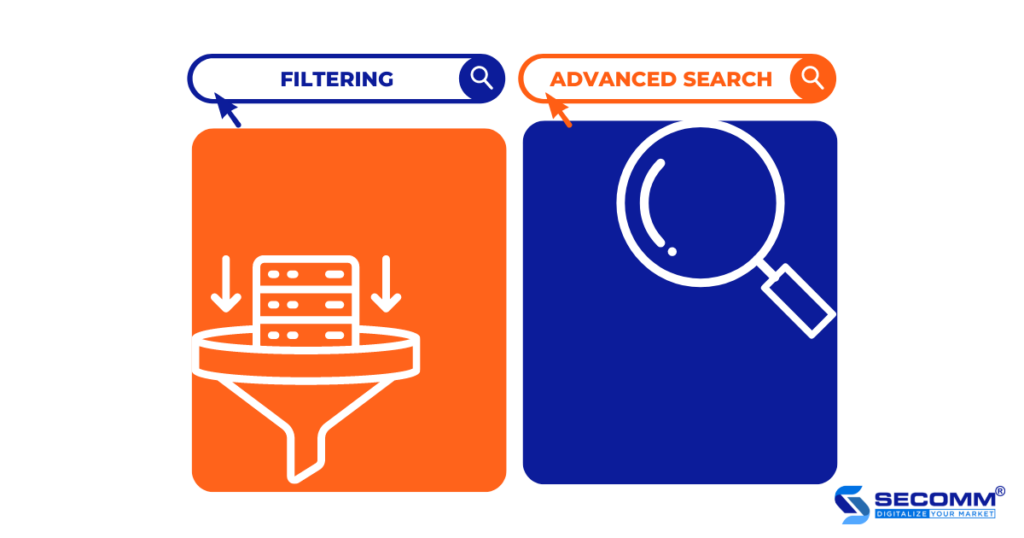
The image search feature, for example, allows users to upload a photo of a favorite item and have the eCommerce website’s search engine return products that are the same, nearly identical, or similar to the product the customers are looking for.
If users don’t know what to look for and need some suggestions, they should browse the website’s product categories. In these cases, the multi-layered product catalog function is extremely useful. In other cases, customers already have search objectives; a search bar with advanced support functions will also assist customers in finding the products they require with a few clicks.
Because online shopping and payments are becoming incredibly popular, it is critical to provide the appropriate payment options when developing an eCommerce website. According to the Payment Methods Report 2019, many shoppers abandon shopping carts because of delivery costs (55%) and complicated checkout processes (26%).
As a result, depending on the product and market that the company is targeting, the company will select a payment method that is appropriate for customers, products, and regions. The most popular payment methods in North America, according to Hostgator, are PayPal, Amazon Pay, Google Pay, Apple Pay, Visa or MasterCard, and so on.
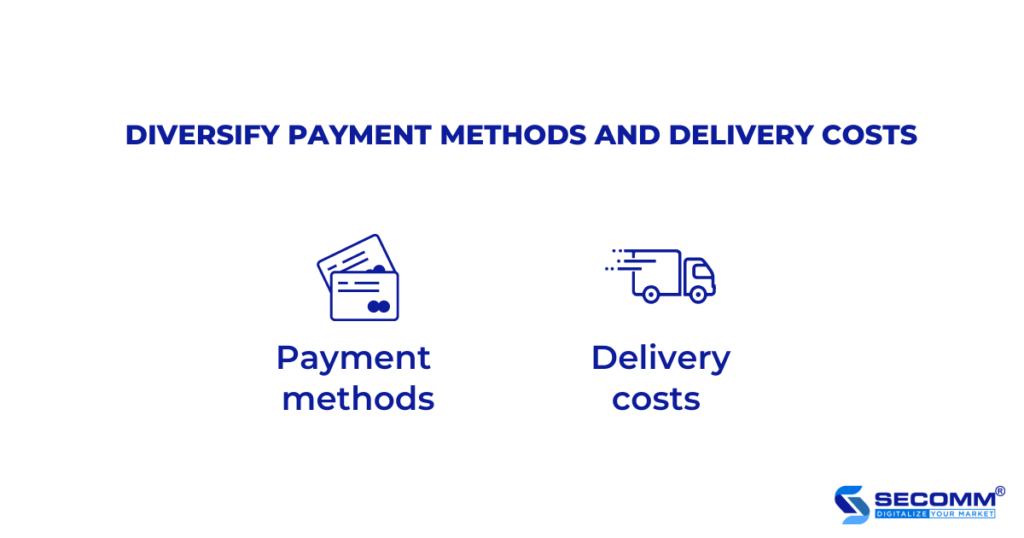
MoMo, Zalo Pay, Shopee Pay, Visa or MasterCard, and others will be particularly popular in the Vietnam market.
Furthermore, businesses should consider delivery costs because this is one of the primary reasons why customers abandon the purchasing process. Businesses can deploy flexible free shipping offers on special promotions, or if customers are required to pay shipping fees, the system should provide detailed information to avoid confusion and create a bad customer experience.
A content management system (CMS) allows you to centrally store and manage your written, visual, and document content. Businesses can change or add information, and the changes will be reflected on the eCommerce website. CMS can also help staff respond more quickly to customer feedback.
Most Internet shoppers are Millennials, Gen Y, and Gen Z. These generations value personalization, such as personalized recommendations, recommendations, or solutions from the support team.
Many eCommerce businesses are trying to meet this, the customer care department will help buyers solve problems during the purchase, payment, delivery, returns, complaints, and so on.
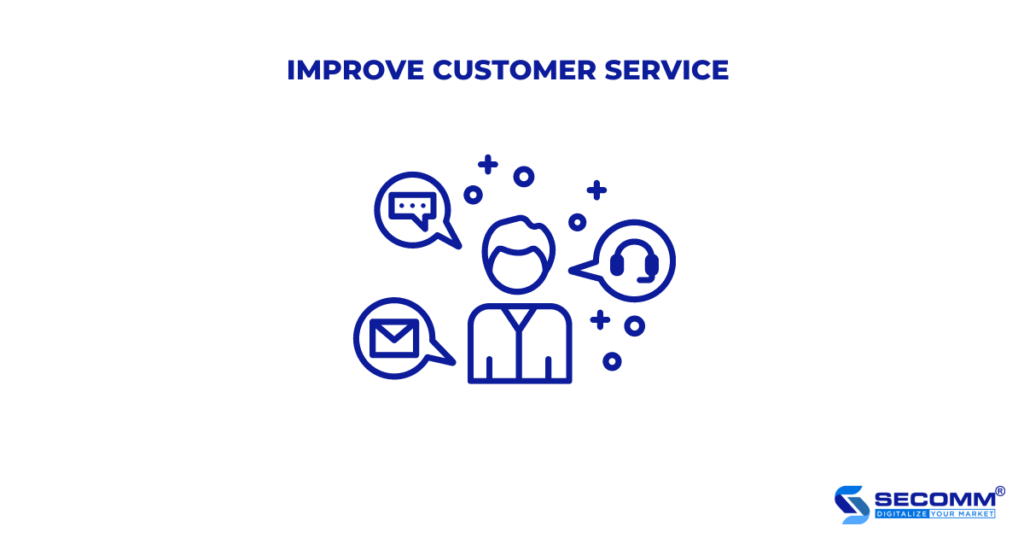
Furthermore, businesses should add a contact section to their eCommerce website with a hotline number or email that can be easily clicked or linked to the Facebook Messenger application, Zalo, live chat for orders, and general support chat for those who prefer this method of communication.
Businesses will be responsible for storing large amounts of user data and product information on an eCommerce website, so safety and security are the most important factors for any eCommerce website. Any negligence can put the company in danger of permanent data loss, and customer information can be stolen and sold.
Google and other search engines will flag an eCommerce website if it is deemed unsafe and has poor security, such as no SSL certificate and HTTPS protocol. This is considered a warning or recommendation for Internet users to be cautious about accessing websites that lack the above two components, as a result of which businesses will easily lose a large number of potential orders, causing marketing disruption and affecting the brand’s reputation.

Furthermore, businesses must register an eCommerce website with the Ministry of Industry and Trade at the eCommerce Management Portal to demonstrate the website’s transparency following Vietnamese Government Decree 52/2013 ND-CP.
The 10 essential factors listed above are those that businesses must consider when implementing eCommerce. In reality, even when businesses use WordPress, the Woocommerce plugin, or a SaaS platform like Shopify, it is not easy to create an eCommerce website with full features that work well to attract customers. If your business decides to hire a website development company, that company must be capable of creating a comprehensive eCommerce website in terms of both design and functionality.
With many years of experience implementing eCommerce in many countries, SECOMM provides free consulting services with professional eCommerce solutions.
Contact us today for free support and advice!
 2
2
 4,997
4,997
 0
0
 1
1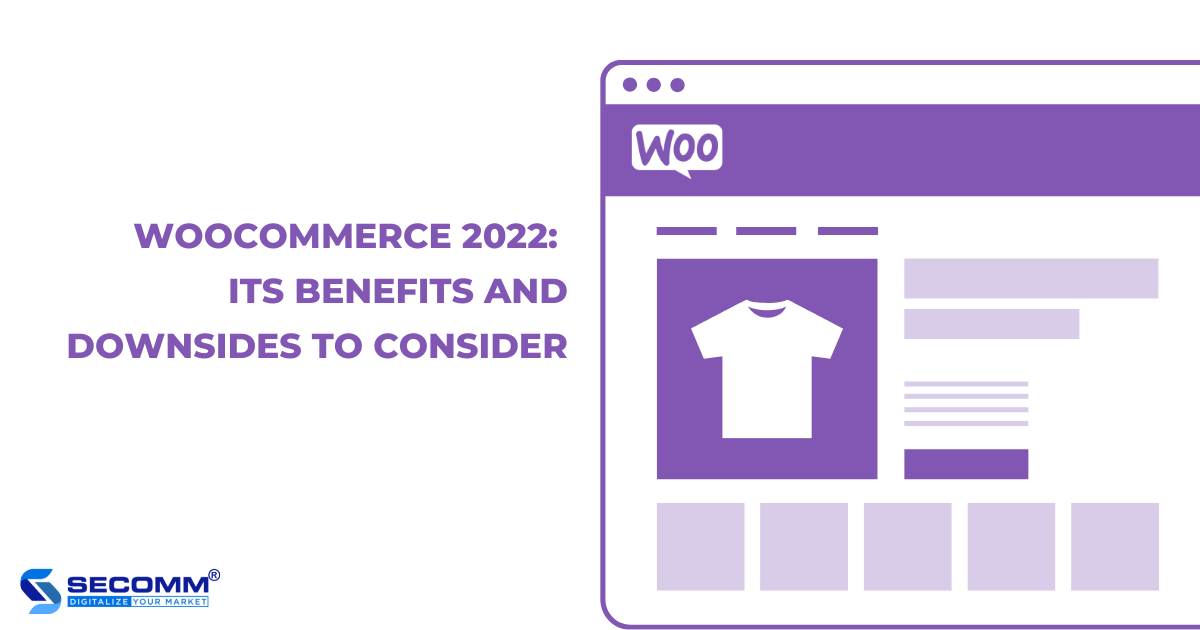
As eCommerce becomes a new trend that encourages a slew of brands to enter the market, selecting the right eCommerce platform to build a successful eCommerce website becomes critical. While Shopify is the most popular SaaS platform, Magento is the top choice in the open-source platform, and the WooCommerce plugin has won the trust of many brands due to its outstanding features and ease of use.
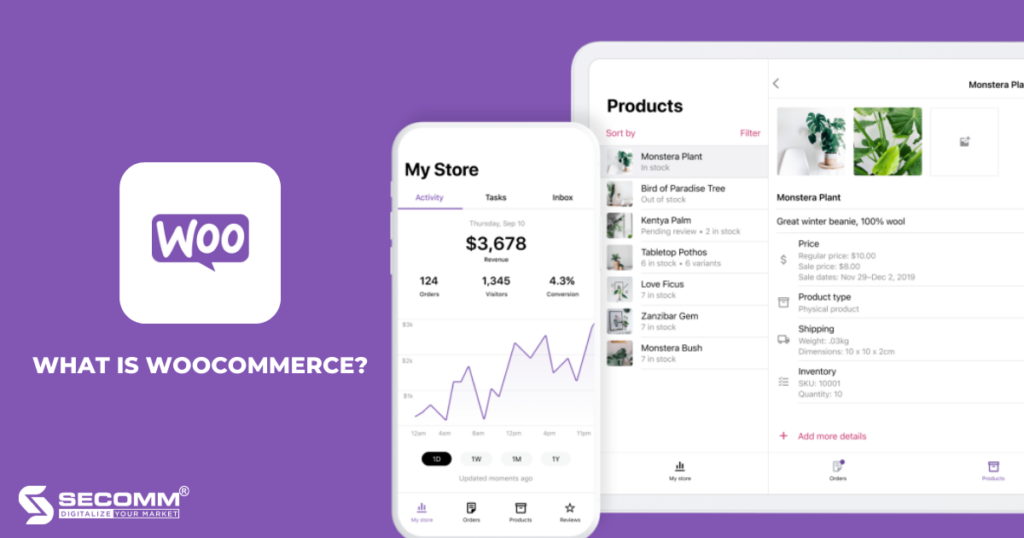
WooCommerce is a free WordPress plugin that allows brands to set up an eCommerce website by adding eCommerce functionality to an existing WordPress site. This plugin can transform a regular WordPress website into an eCommerce website with all the necessary features and easy customization with just a few clicks.
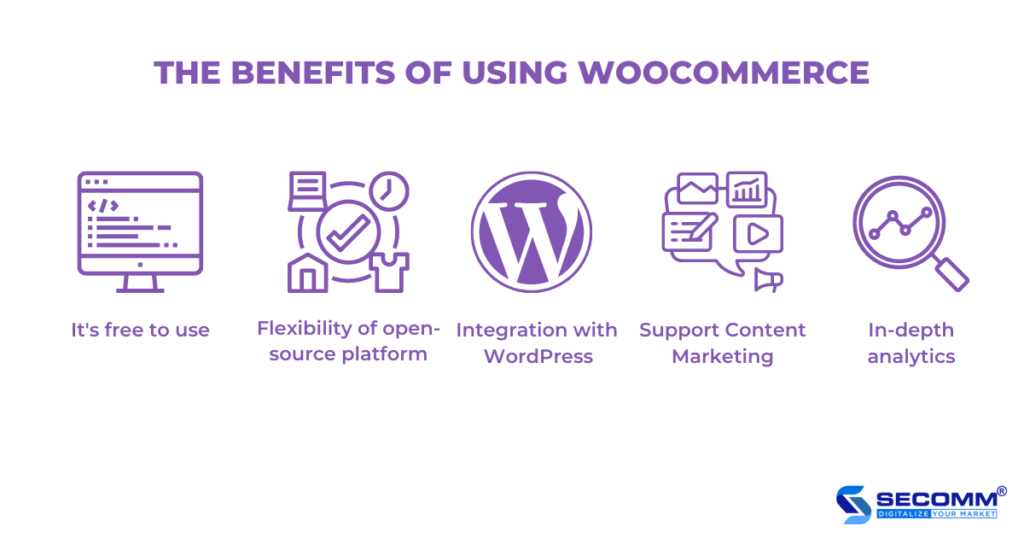
Price is an essential factor to think about when selecting a platform for implementing eCommerce. Popular platforms on the market today have prices ranging from free to several thousand dollars per year, making it even more prominent and preferred by businesses because this plugin is entirely free to download and install.
As a result, any business can benefit from its features without committing to costly support contracts or software licenses.
It is an open-source plugin built on the WordPress CMS that gives users complete control and allows them to easily customize their eCommerce website to their specific needs. WooCommerce, in addition to being suitable for a variety of businesses serving different customer segments, also provides long-term scalability, giving businesses of all sizes more flexibility in deploying eCommerce.
The seamless integration between WooCommerce and WordPress brings many benefits to this plugin because of the availability of the large WordPress community throughout the years. WooCommerce can take advantage of the platform’s massive ecosystem of plugins, themes, guides, and other unique features.
Yoast SEO, for example, has long been a well-liked plugin with numerous international translations, ease of use, and advanced SEO support. Since WooCommerce integrates with WordPress, Yoast SEO also integrates with WooCommerce.
Especially when a business has a website on the WordPress platform and needs to turn it into an eCommerce website, WooCommerce will make it easy and seamless, so users do not have to start over with a brand new platform.
Content Marketing is the key to an effective eCommerce website. If businesses are looking for an eCommerce platform built on the world’s most popular content management system (CMS), WooCommerce can fulfill that expectation.
When the WooCommerce plugin is integrated into WordPress, many content management options, including Blogs, Landing Pages, Product Descriptions, Email Marketing, and SEO plugins (Yoast WooCommerce SEO), will help sellers optimize content for search.
Integrated analytics is another advantage of the plugin because the more you learn about customers and how they interact with your eCommerce website, the more you can adjust to meet customer expectations. For example, businesses can use sales data to learn about customers, thereby establishing a customer persona to increase sales in the future.
Furthermore, it provides a comprehensive WooCommerce analyzer displayed in a clean and user-friendly interface. Businesses can then easily integrate WooCommerce with third-party analytics services such as Google Analytics, Google Tag Manager, and others.

When using this plugin, the user is responsible for keeping the eCommerce website up-to-date, accessible, and functional. In fact, there is some support from the hosting company and the WooCommerce community, but it does not allow users to simply call for technical assistance.
Plugins will notify users of security updates, but users must install and handle problems themselves. In fact, hosting companies will support this. Still, users need to have a bit of technical knowledge to facilitate the process of supporting related issues to avoid affecting the performance of the eCommerce website.
This disadvantage stems directly from the fact that businesses have complete control over the eCommerce website system’s source code and data. Maximum authority entails maximum accountability. Although businesses continue to receive support for WooCommerce issues, compared to other eCommerce platforms such as Shopify, BigCommerce, Magento, etc., WooCommerce still has many shortcomings in the technical maintenance support process.
With the constant increase in unauthorized access (Website Hacking), website speed and security are more critical than ever. Speed and security are significant advantages for SaaS platforms such as Shopify and BigCommerce. At that point, your eCommerce website is housed in the infrastructure of these platforms, and a team of technical experts will continuously monitor and resolve any issues that arise to keep the website running smoothly.
Similar to a technical maintenance situation, WooCommerce essentially leaves the user responsible for the speed and security of the website despite the wide range of 3rd party support options.
Although speed and security are not an issue for some new businesses deploying eCommerce websites, this is still a significant drawback of this plugin when businesses are responsible for many issues ranging from technical maintenance to website speed and security, especially if the eCommerce site is on the verge of rapidly growing from hundreds to thousands of hits.
Because it is a WordPress plugin, it will operate in accordance with WordPress functions. Meanwhile, WordPress functionality is not explicitly designed for eCommerce but rather is based on the flexibility of open-source code. This means that when a user exceeds a certain query threshold, the way WooCommerce works is broken.
For example, when a large number of shopping carts are added, or checkout occurs at the same time, or when too many users visit the website simultaneously, overload occurs, making the operation of the eCommerce website difficult. This is difficult because the WordPress system and the WooCommerce plugin are no longer compatible.
If your eCommerce website is still small and growing, this is not a problem; problems can still be quickly resolved. However, as the size of your website expands and grows rapidly, this is a disadvantage in terms of both performance and cost that businesses must consider before proceeding.
In a nutshell, WooCommerce is a fantastic plugin that many businesses would love to choose when deploying an eCommerce website. However, besides the outstanding advantages, there are still certain downsides, so businesses must carefully consider and compare with other platforms before starting out.
With many years of experience implementing eCommerce in many countries, SECOMM provides free consulting services with professional eCommerce solutions.
Contact us today for free support and advice!
 2
2
 5,480
5,480
 1
1
 1
1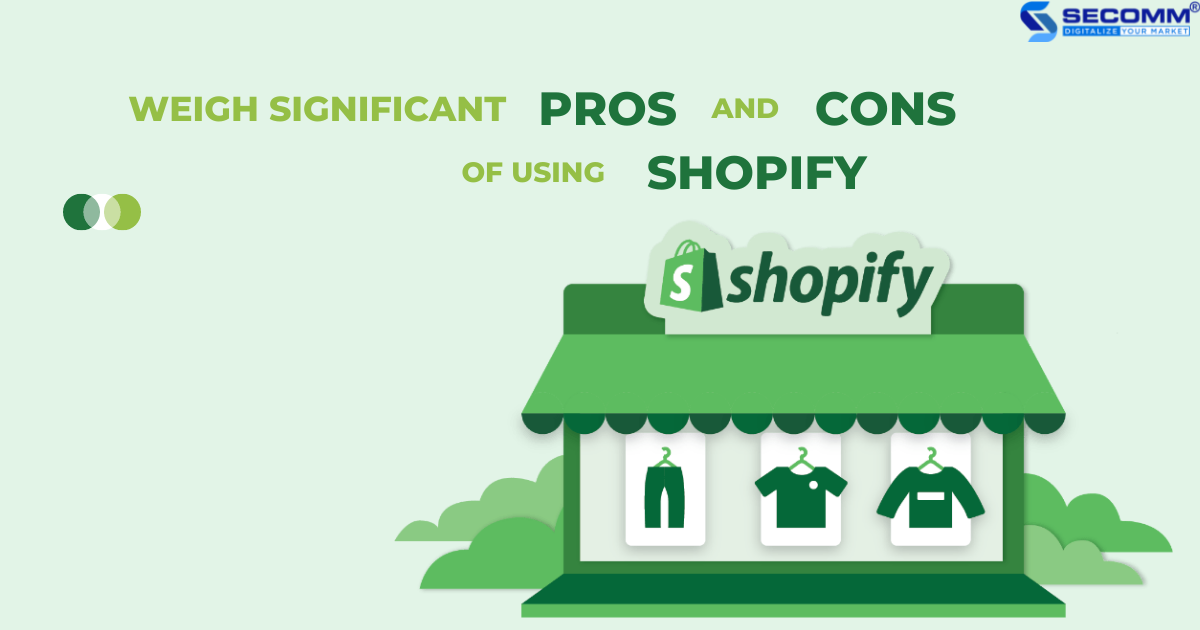
Today, for businesses of all sizes, eCommerce websites play an essential role in reaching and buying products for a wide pool of potential customers on the Internet.
Thus, choosing the right platform to build an eCommerce website is incredibly important. A good eCommerce platform will make it easy for businesses to provide Omnichannel experiences, personalize customer experiences, offer a variety of services, products, and more to increase conversions and drive online sales.
Some commonly mentioned platforms for building eCommerce websites are Magento, Woocommerce, Bigcommerce, etc. Definitely, each business will have its considerations, but one platform that always appears as a top choice is Shopify. In spite of the fact that the platform is highly rated, businesses should still weigh the pros and cons of this platform before making a final decision.
As a result, SECOMM has prepared this review, helping businesses understand what Shopify is, how it works, implementation costs, and especially the pros and cons of using this platform to build a comprehensive eCommerce website.
Before becoming one of the most popular eCommerce platforms globally, Shopify started as an online ski store called Snowdevil in 2004. Later, the company transformed into an eCommerce platform named Jaded Pixel.
In 2006, It was officially founded in Ottawa by young programmers Tobias Lutke, Daniel Weinand, and Scott Lake. Since then, the platform has gradually affirmed its position as a reliable and fastest-growing eCommerce platform in the last two years when most companies faced many difficulties because of the Covid-19 pandemic.
Up to now, the number of Shopify users has increased significantly. As reported by StoreLeads, there are currently about 2 million websites using the platform to build and develop online businesses. In the second quarter of 2022, the number of newly opened stores reached 150,928, an increase of 10.8% compared to the same period in 2021. In Vietnam alone, there are about 2,000 websites using the platform in operation, up 9.8% in the second quarter of 2022 over the same period in 2021.
Total revenue in the second quarter of 2022 reached $1.3 billion, up 16% over the same period in 2021, corresponding to a compound annual growth rate for three consecutive years of 53%. Gross profit in the second quarter of 2022 increased by 6% to $655.6 million compared to $620.9 million in the second quarter of 2021 (According to Shopify’s report).
While it is one of the most popular and user-friendly eCommerce platforms available today, businesses still need to determine if this is what they need to expand their business, all the advantages and disadvantages of the platform, mostly the cost issue.
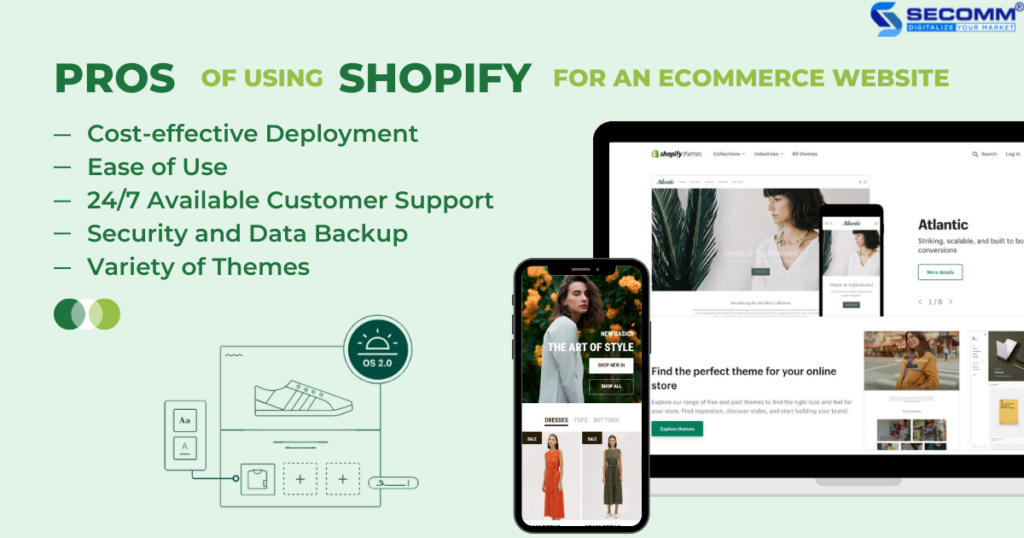
For a start, businesses can enjoy a 14-day free trial without a credit card requirement. When the free trial ends, businesses are encouraged to opt for one of the solution packages with suitable features and appealing promotions.
Packages | Price | Main Features | Unique Features | Ideally suited for |
Starter |
| Create product pages and get shareable links with product information, then send those links to customers via social platforms or message apps. | Merchants that sell on social platforms or message apps with no website in demand | |
Lite |
| – Shopify Buy Button. – Invoicing. | Merchants that sell on an existing website or social platforms. | |
Basic |
| – Customizable website editor. – Website hosting and free TSL certificate. – Unlimited number of products. – Analytical reports – Localization: currency conversion, website translation, regional domains. – Inventory Management. – Shopify POS. – Shopify Email. -Shopify Payment. – 24/7 Customer service. | – 2 staff accounts. – 4 inventory locations. – Basic reports. | Businesses who have just entered or intend to enter the eCommerce world and look for comprehensive eCommerce solutions. |
Shopify |
| – 5 staff accounts. – 5 inventory locations. – Standard reports. | Steadily growing eCommerce businesses. | |
Advanced |
| -15 staff accounts. -8 inventory locations. – Advanced reports. – Automation tools. | Large-scale businesses that sell internationally | |
Plus | Từ $2000/month. However, businesses can contact Shopify for a custom estimate. | – 9 expansion websites. – Up to 100 themes. – Exclusive Merchant Success Program, Shopify Plus Academy, Shopify Plus Partner , Shopify Plus Community on Facebook | Enterprise-level businesses that manage and operate multiple eCommerce websites. |
Table list of price, and features of Shopify solution packages.
First and foremost, because it is a SaaS platform, the cost to get started is usually quite low. Despite the fact that businesses must pay monthly fees, transaction fees, theme fees, and extension fees, Shopify is still significantly less expensive than open-source platforms such as Magento, WooCommerce, and others.
The development of an open-source platform necessitates the assistance of experienced programmers and takes a long time to deploy, whereas the SaaS platform is the inverse. That is the reason why starting with a SaaS platform, specifically, Shopify, will save businesses both time and expense.
Another cost highlight is that SaaS platforms, in general, and Shopify in particular, require an ongoing monthly fee rather than a one-time purchase fee to use the platform. This reduces the risk of businesses investing too much money in the platform but not meeting their expectations during the implementation process.
Furthermore, the Shopify platform is appropriate for different-sized businesses in the market. The Starter, Lite, and Basic packages are appropriate for SME businesses engaged in eCommerce. Shopify, Advanced, and Plus packages are ideal for large-scale businesses that require advanced features to run an effective eCommerce website.
The only way to adapt to the ever-changing market and quickly reach a wide pool of potential customers is for businesses to deploy eCommerce websites as soon as possible to avoid being left behind in the competition of the digital transformation race. One of the important factors when building an eCommerce website is choosing the right platform.
In particular, the top goal to consider when choosing an eCommerce platform is the ease of use. If a platform takes users too long to learn and implement or makes users dependent on external support, then the platform is not easy to use
Shopify has an easy-to-use interface for users with little programming knowledge. Moreover, Shopify is a SaaS eCommerce platform with a pre-designed system that offers hosting, interface, features, and technology infrastructure maintenance, allowing businesses to easily build and operate the website system with just drag and drop without worrying about technical issues.
Simple steps to get started with the eCommerce website implementation with Shopify:
This is one of the most crucial factors influencing users’ decision to use Shopify. Difficulties and obstacles are inevitable when building an eCommerce website, so Shopify has assembled a reliable and trusted team to assist users.
As a result, if your business requires assistance, assistance is available 24/7. Businesses can reach Shopify via email, chat, and a hotline worldwide. What’s more, users can access community forums and useful documents for developing eCommerce websites on this platform, mostly through the Shopify Support Center.
The Shopify platform runs on PCI (Peripheral Component Interconnect) compliant servers, allowing merchants to accept credit card payments. Secure Sockets Layer (SSL) encryption is enabled on all Shopify websites to secure visitor data, while a backup system allows businesses to store and save data regularly by exporting data to a CSV file.
As an outcome, the platform encourages the addition of an advanced backup solution from the Shopify Store, such as the Rewind app, as it is seen as a lifesaver if users accidentally delete content such as products or images or a video demonstration. To keep your eCommerce website secure, simply back up your data on a regular basis and use a strong enough admin password.
The interface is the appearance of a business’s eCommerce website. The more appealing the website interface, the more likely it is to retain customers, attract more visitors, as well as generate more conversions.
Shopify understands the importance of a website interface, so it has made a host of available themes, both free and paid, suitable for a wide range of businesses and fields, making it simple for businesses to choose from.
The free Shopify themes are ideal for startups, small and medium-sized businesses, and individuals. Businesses can customize their eCommerce website according to their needs and brand features by using features such as responsive web design, product filters, and product color display templates.
However, free themes have some downsides, including a limited number of themes, limited design, and a lack of advanced and specific features, which makes website customization difficult.
In fact, free themes are great for launching an eCommerce website. Premium interfaces, also known as paid themes, will be more suitable for large-scale businesses or businesses on the rise, with an average cost of around $140-$180/theme.
Shopify’s paid themes include advanced integration features such as live chat support, newsletter popups, upsell features, faster page loading, and much more. Thereby, businesses can run an eCommerce website automatedly and smoothly.
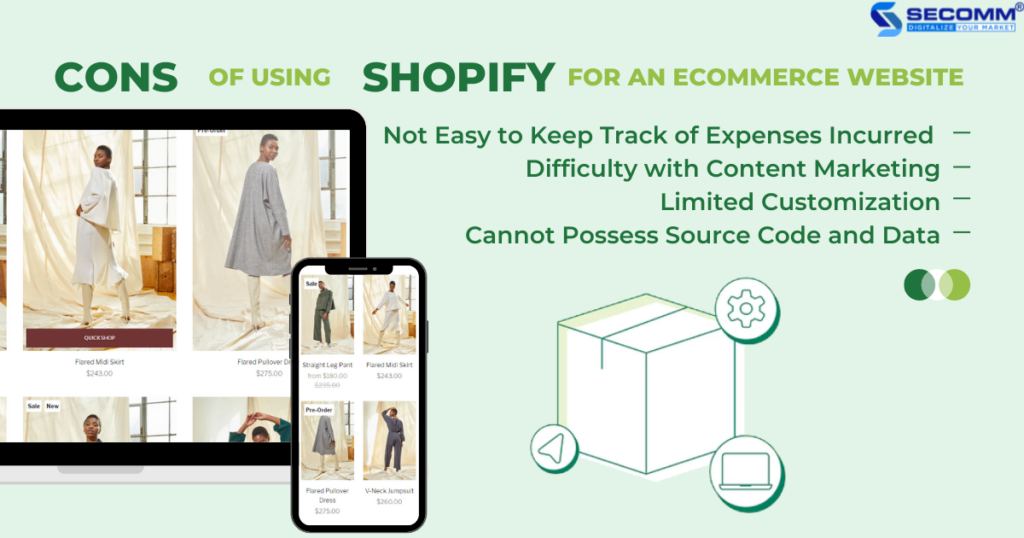
The cost of using Shopify, besides the notable pluses, the platform has a small but enough minus to make some businesses hesitate to start.
In addition to the monthly fee for using the enterprise platform, businesses must pay for other costs such as themes, applications, extensions, marketing features, sales, and SEO on a monthly basis with no long-term possession.
For example, to use the Free Shipping & Hello Bar application that offers free gifts, free shipping, or other types of promotions, users will buy for $8.95/month, which means ongoing monthly in regards to other expenses, businesses will pay an additional $8.95 for this app until it is no longer used.
When there are small expenses incurred each month, it is difficult to control cash flow for large-scale businesses that have to manage and operate many websites at the same time.
Meanwhile, open-source platforms require a one-time purchase fee rather than an ongoing monthly fee. Although the features are not yet available and take a long time to program, businesses can possess those features for eCommerce websites in the long run. Thereby, it makes cash flow management more convenient and effective.
It is a great way to promote your eCommerce website. Users can use Shopify to blog and optimize SEO, drive free traffic, and improve brand positioning.
However, this blogging feature on Shopify is not as user-friendly as WordPress. Some of the criteria Shopify can improve regarding blogging and content writing include:
This will be a barrier for businesses when using Shopify to promote eCommerce websites by optimizing SEO if the content is a core element of the business’s marketing strategy.
Another limitation of Shopify is that the platform’s interface is customized using the Shopify Liquid setup. Meanwhile, many website developers are already familiar with the PHP programming language to customize the themes and templates of the website, it is a common technique used by WordPress.
Therefore, users who do not have much experience in programming will face many obstacles when using Shopify’s tools to customize the interface of the eCommerce website.
However, businesses of all sizes can still use other useful Shopify features like Shopify Themes, Shopify App Store, Shopify Blog, 24/7 support team, and more to set up an eCommerce website quickly and effortlessly.
Because the entire business’s website system is hosted on Shopify’s server, the ownership and control of the website source code will belong to Shopify, not the business. Similar to other SaaS platforms such as BigCommerce, Squarespace, Wix… Shopify has a Lock-in feature, which means that when converting a website from one platform to another, businesses will no longer be able to use the old website source code and have to rebuild from scratch on a new platform.
Similar to the source code, business data is also stored on Shopify’s servers, so data ownership and control are quite limited. This makes it difficult for businesses to connect data among internal departments or users’ personalization, etc. Especially when switching platforms, data loss or misalignment is often unavoidable.
Shopify will not assist in the event that businesses stop using the platform for any reason. The only asset businesses can keep and take away is a CSV report containing website information.
Hence, before starting an eCommerce website on the Shopify platform, businesses need to carefully consider the benefits and disadvantages of stopping using it to conclude whether Shopify is the best fit for business in the long run.
Going by this article, Shopify is one of the eCommerce platforms that many businesses would love to choose when deploying an eCommerce website. However, besides the outstanding advantages, there are still certain downsides, so businesses need to carefully consider and compare with other platforms before starting out.
With many years of experience in implementing eCommerce in many countries, SECOMM provides free consulting services with professional eCommerce solutions.
Contact us today for free support and advice!
 2
2
 4,943
4,943
 0
0
 1
1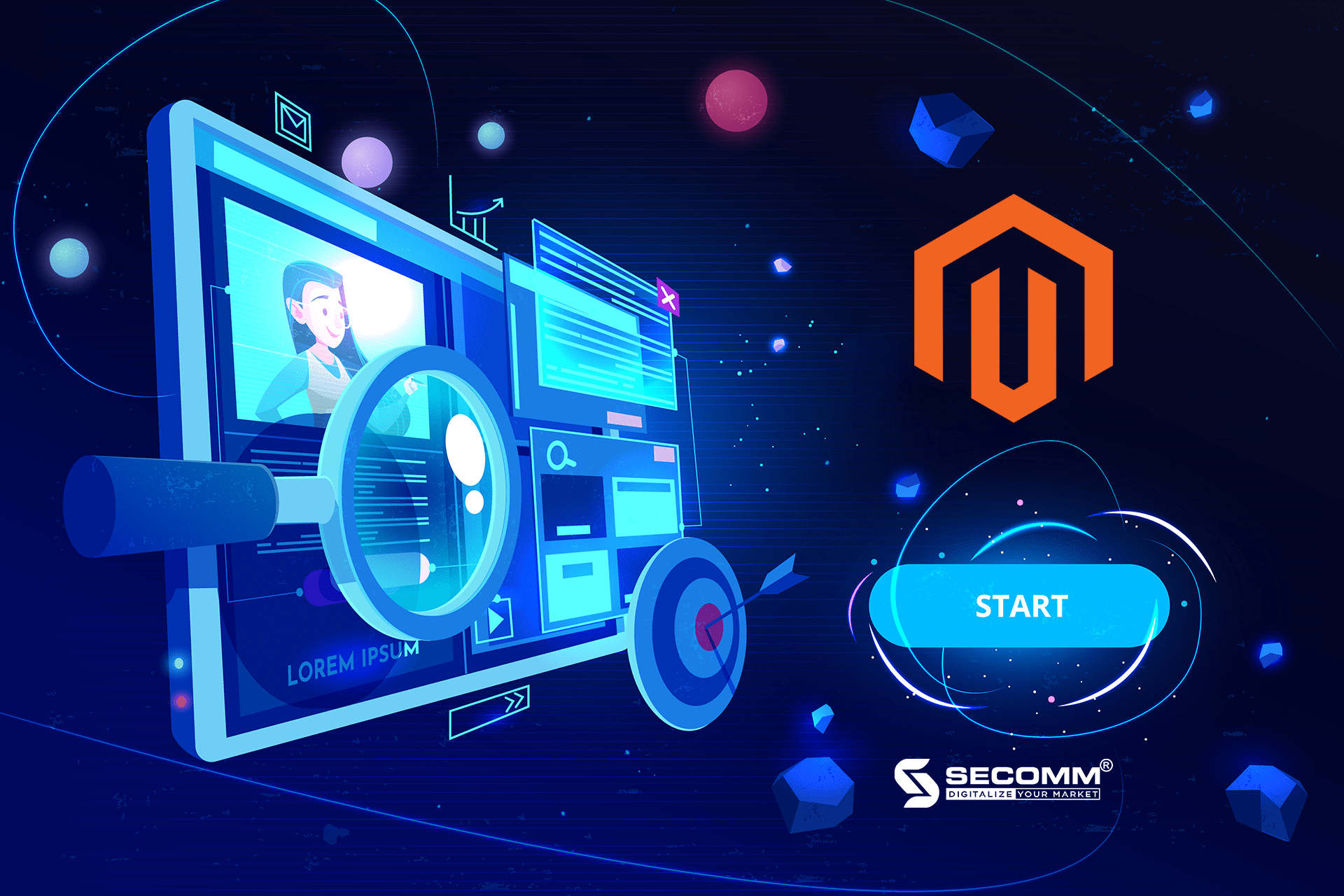
Platforms play a significant role in developing and operating an optimal eCommerce system. As a result, selecting an eCommerce platform should be done thoroughly and carefully to maximize the platform’s benefits and promote long-term business growth. Each business’s eCommerce model will have appropriate platform options depending on the development goals. However, most SMEs today face significant challenges in selecting a suitable eCommerce platform due to a variety of budget, time, and business characteristics.
The Magento eCommerce platform is the most fantastic platform for eCommerce systems among popular names such as Shopify, BigCommerce, WooCommerce, and so on. Magento has many distinct advantages, including high flexibility, a diverse ecosystem, and optimal security. However, are Magento’s outstanding features the best option for SMEs? So, what are the standout characteristics of the Magento eCommerce platform? Will they be appropriate for SMEs in the Vietnamese market?
The Magento eCommerce platform is designed to grow into a comprehensive eCommerce system.
+ Integrate Google Analytics to track and report on traffic, audience, purchasing process, and purchasing behavior.
+ Integrate Facebook Pixels makes tracking ads performance and capturing website actions simple.
+ Integrate Google Tag Manager to quickly update website metrics and related tags to increase personalization and accomplish the proper goals for the subsequent Marketing campaigns.
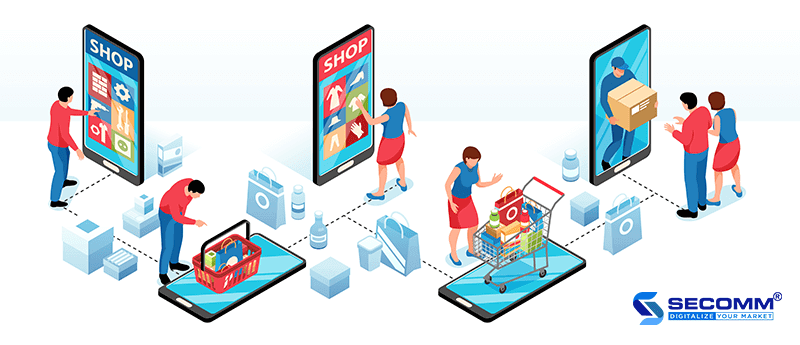
The Magento extension system has also been significantly developed to meet the eCommerce market’s rapid development and the specific requirements of each business.
Thousands of advanced functions on themes, add-ons, products, Marketing, payment optimization solutions, shipping, and so on have been built with flexibility and high usability to deliver exceptional results when integrated into the system that meets all operational needs and ensures the long-term growth of businesses’ eCommerce.
Businesses can fully integrate third-party services, analytics tools, management software, and Omni-channel with the Magento eCommerce platform to support efficient and seamless eCommerce operations.
In addition to a fully functional feature system, the Magento eCommerce platform is supported by a diverse system of extensions and technologies from a global developer community, allowing all eCommerce requirements of SME businesses to be met quickly anytime, and anywhere. The Magento eCommerce platform has a large developer community worldwide, including many experienced professionals and Magento developers.

Businesses will receive maximum support in solving problems arising from technical errors and consulting on building eCommerce solutions that fit the enterprise’s business model with a strong Magento eCommerce platform development community.
An extensive technical support community is another example of the reliability and capacity to quickly resolve system errors and updates that Magento constantly brings to our eCommerce system.
The Magento eCommerce platform’s flexibility is an exceptional advantage that allows the Magento eCommerce platform to operate any complex system. Given this benefit, Magento is an excellent choice for Vietnamese SMEs today. Moreover, businesses can easily change system functions, develop new features, or open new stores to meet their needs and respond to rapid market change.
The Magento eCommerce platform possesses the advantages of open-source software with extensive customizability to help the system run smoothly. Enterprises can easily own and control the entire system source code and customize it to change parts to suit the eCommerce system’s general operating model.
Owing to this benefit, Magento is highly customizable for any size business and can meet the eCommerce needs of both small and large corporations.
Besides that, the customizability of open-source code enables developers to create more innovative and comprehensive solutions tailored to each business, field, and business model, creating highly specialized eCommerce functions that result in effective system performance.
Magento allows businesses to scale from one website/store to many different websites/stores on the same system to meet the needs of business scale development. Businesses can access and manage all data from multiple websites/stores using a single Magento system.
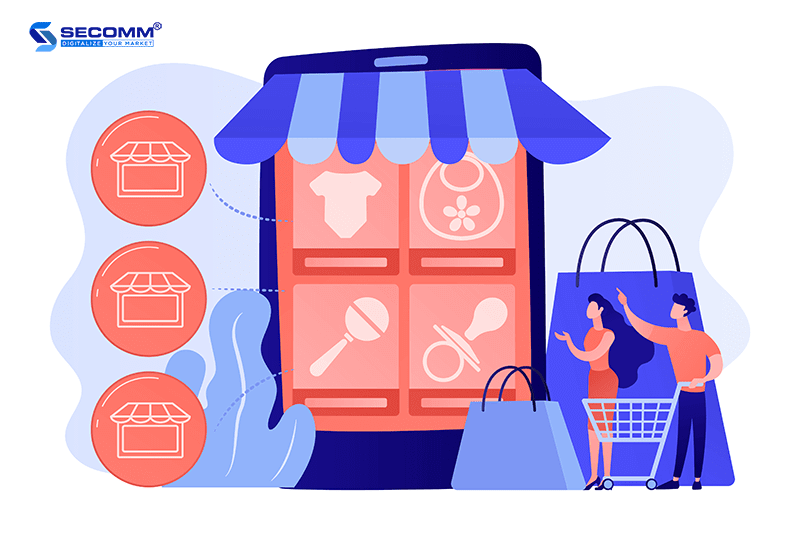
With Magento’s language conversion support, businesses can create an eCommerce system with customer-friendly content and language. Besides that, the Magento system enables businesses to quickly convert currencies, expand their markets in many countries, and assist customers in transacting conveniently and having the best shopping experience.
High security is another significant benefit that makes the Magento eCommerce platform the preferred choice for SMEs. Magento is a complete eCommerce system with security functions that ensure seamless eCommerce operation while minimizing potential data system and ecommerce transaction processing risks. As a result, system security is improved, website credibility is increased, and user interests are protected to the greatest extent possible.

Magento includes a periodic security scan tool to identify security issues or malware affecting the system and update patches and notifications, then propose security solutions to handle arising errors, thereby effectively improving and optimizing the website’s security.
The requirement to use advanced passwords should also be fully implemented to increase the level of security for administrative accounts. The administrator password must be at least seven characters long and include letters, numbers, and special symbols. Relating to further adjustments, the password complexity may be increased with lower case/case sensitivity, or re-login may be required after a certain length of the login session.
CAPTCHA can protect the system for both administrators and website visitors. In addition, using CAPTCHA aids the system in preventing bot spam and malicious code from entering the system illegally.
This function provides additional security for system user accounts. Accordingly, customers will have to authenticate with an additional OTP security code sent to the phone number provided during account registration after logging in with a password. This two-layer security operation effectively limits the threats of unauthorized access and account attacks while enhancing protection and maximum safety for system users.
With significant advantages such as a fully functional feature system, flexibility, a diverse ecosystem, and optimal security, the Magento eCommerce platform is the best choice for SMEs looking to build a stable and sustainable eCommerce system. However, due to deployment costs, implementation time, and complex industry-specific issues, most SMEs are still hesitant to use Magento to build an eCommerce system.
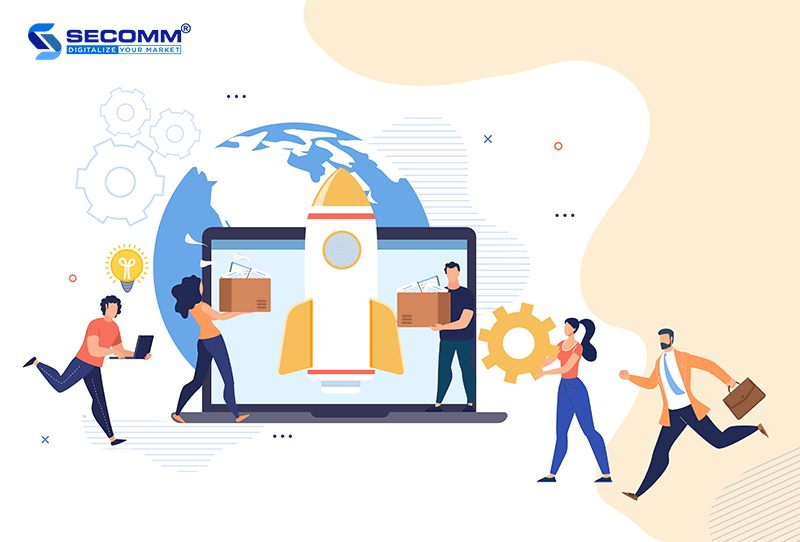
Although Magento is highly regarded for its features and performance, the cost barrier prevents SMEs from selecting the Magento eCommerce platform to build their system. Furthermore, the expertise of the system developers is a significant factor that significantly increases the cost of Magento implementation. Therefore, a complete and efficient Magento eCommerce website is implemented by a professional team that is thoroughly knowledgeable about Magento to develop the proper comprehensive system from the beginning and provide appropriate solutions for the enterprise’s various needs in the long run.
A fully functional system built on the Magento eCommerce platform is estimated to cost between $10,000 and $100,000.
A complete project on the Magento eCommerce platform typically takes 2-3 months to deploy, with some projects taking up to a year. Additionally, enterprises should constantly develop components of the eCommerce system. Furthermore, the functional system’s complexity necessitates time investment to build appropriate development solutions.
When selecting an eCommerce deployment platform, SMEs should consider the time issue carefully. With the requirements of the eCommerce and digital transformation markets, the extended system implementation time slows down the digital transformation process, making it difficult for businesses to keep up with competitors or constantly update trends in the market.
When converting to eCommerce, the specific characteristics of each industry and field remain a complex problem for every SME. Because most Vietnamese SMEs lack the technical knowledge and expertise required to build particular functions that can satisfy one or more specialized processes and the complexity of the eCommerce system, industry specificity has become a significant obstacle. These specific functions necessitate a corresponding technological solution to ensure that the eCommerce system can operate effectively and sustainably after the transformation.
Simultaneously, to build a specific feature with high complexity for a Magento store, businesses may need to spend more money and time than usual to develop a suitable solution to the particular requirements of an eCommerce business.
With extensive experience developing many complex e-commerce systems on Magento, SECOMM understands the challenges that businesses face when selecting a platform and implementing E-commerce.
Contact SECOMM for a free consultation on comprehensive e-commerce system development solutions!
 2
2
 5,564
5,564
 0
0
 1
1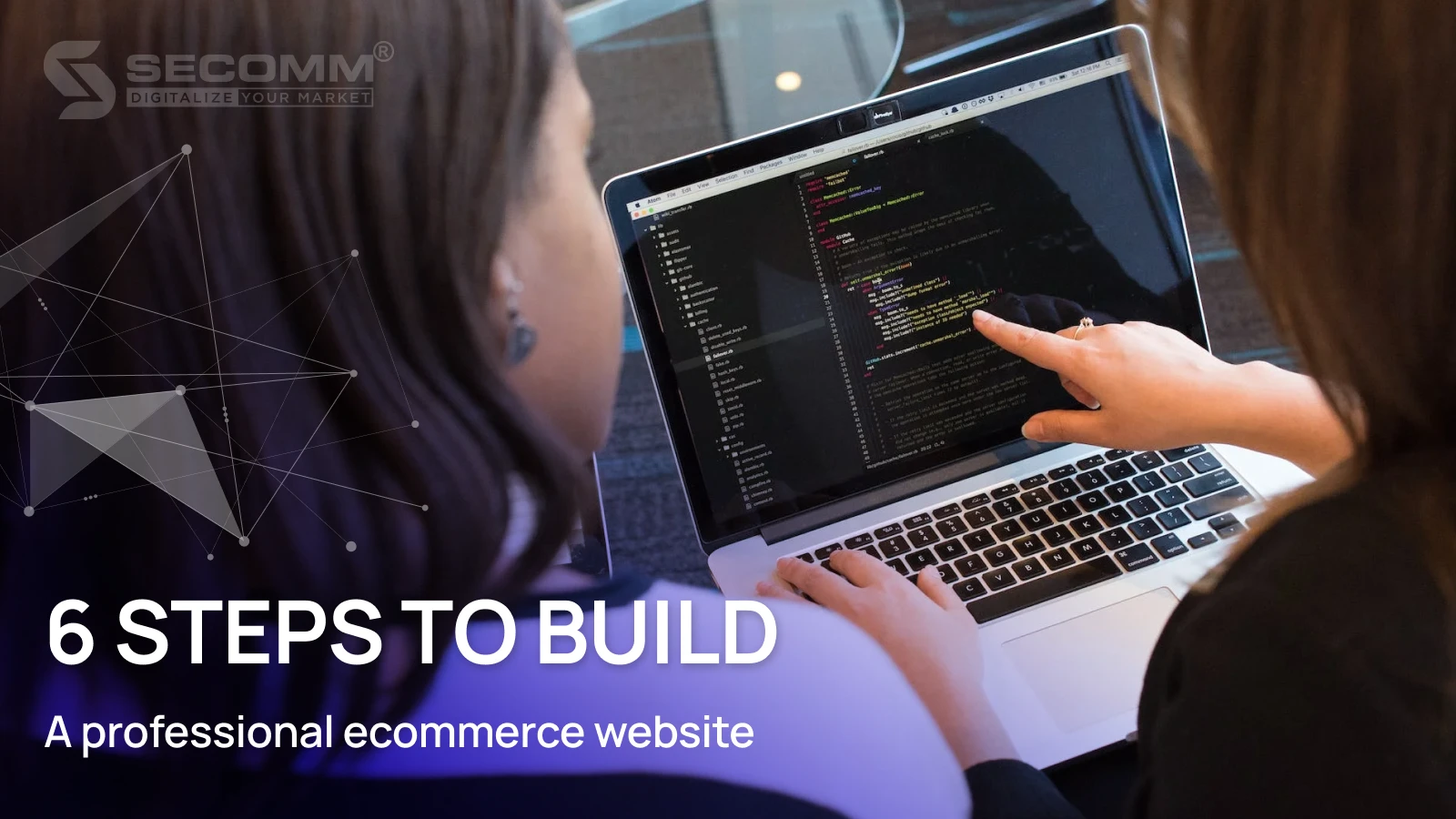
Trends in consumer shopping are shifting from offline to online, especially among the younger generation—an important factor impacting the new economy. Building an ecommerce website is crucial for the success of ecommerce businesses in today’s digital economy. So, what should businesses do to build a professional ecommerce website?
Objectives:
Businesses need to determine the purpose of the website and the priority of each goal to plan the development of the website according to each stage:
Requirements:
The ecommerce website needs to have a powerful configuration, a professional interface, and a diverse system of functions to meet the growing needs of customers. When designing the website, businesses should pay attention to:
Example: The structure of some common pages of an effective e-commerce website:
To maximize the customer experience, the ecommerce website needs to integrate features that support personalized customer experiences, aligning with their shopping behavior.
Example: Some common features:
Depending on the goals and complexity of the e-commerce website, determine the time and budget. To accurately determine the time and budget, businesses should seek advice from experienced and professional units.
Each platform has its advantages and disadvantages. Businesses need to consider choosing a website development platform that is suitable for their e-commerce business strategy. Some popular platforms include:
Suitable for businesses investing in the long term, saving budgets in the long run.
Suitable for building simple and less customized e-commerce websites.
Suitable for building e-commerce websites for new businesses with relatively low revenue.
Criteria for choosing a domain name:
Short and easy to remember
Criteria for selecting a hosting provider:
Configuration considerations: Disk space, bandwidth, parked domains, CPU, RAM, FTP accounts, MySQL accounts, dedicated IP, etc.
Support services: Data backup, 24/7 live chat support, and ticket submission for issue resolution.
When building an e-commerce website, businesses need to collaborate with units based on certain criteria:
Some ecommerce website design units in Vietnam include:
Purchase domain name and hosting
Criteria for choosing a domain name: Short, easy to remember.
Criteria for choosing hosting providers:
Coordinate with the development unit to ensure a smooth development process. Businesses should regularly update the project progress according to the approved solution. Simultaneously, update changes and coordinate with the cooperating unit. During the User Acceptance Test (UAT), businesses should test according to a checklist to ensure that the website development process meets expectations.
During the development process, businesses also need to work with payment and shipping units to provide services for the ecommerce website. When signing contracts with payment units, attention should be paid to security, compatibility between the website platform and the payment platform, and service fees. Some common online payment gateways in Vietnam include Paypal, Ngan Luong, VNPay, Airpay, and e-wallets such as Momo, ZaloPay. When cooperating with shipping units, businesses should consider the quality of services, shipping staff, packaging, and storage of goods to avoid affecting the user experience
 79
79
 32,078
32,078
 1
1
 58
58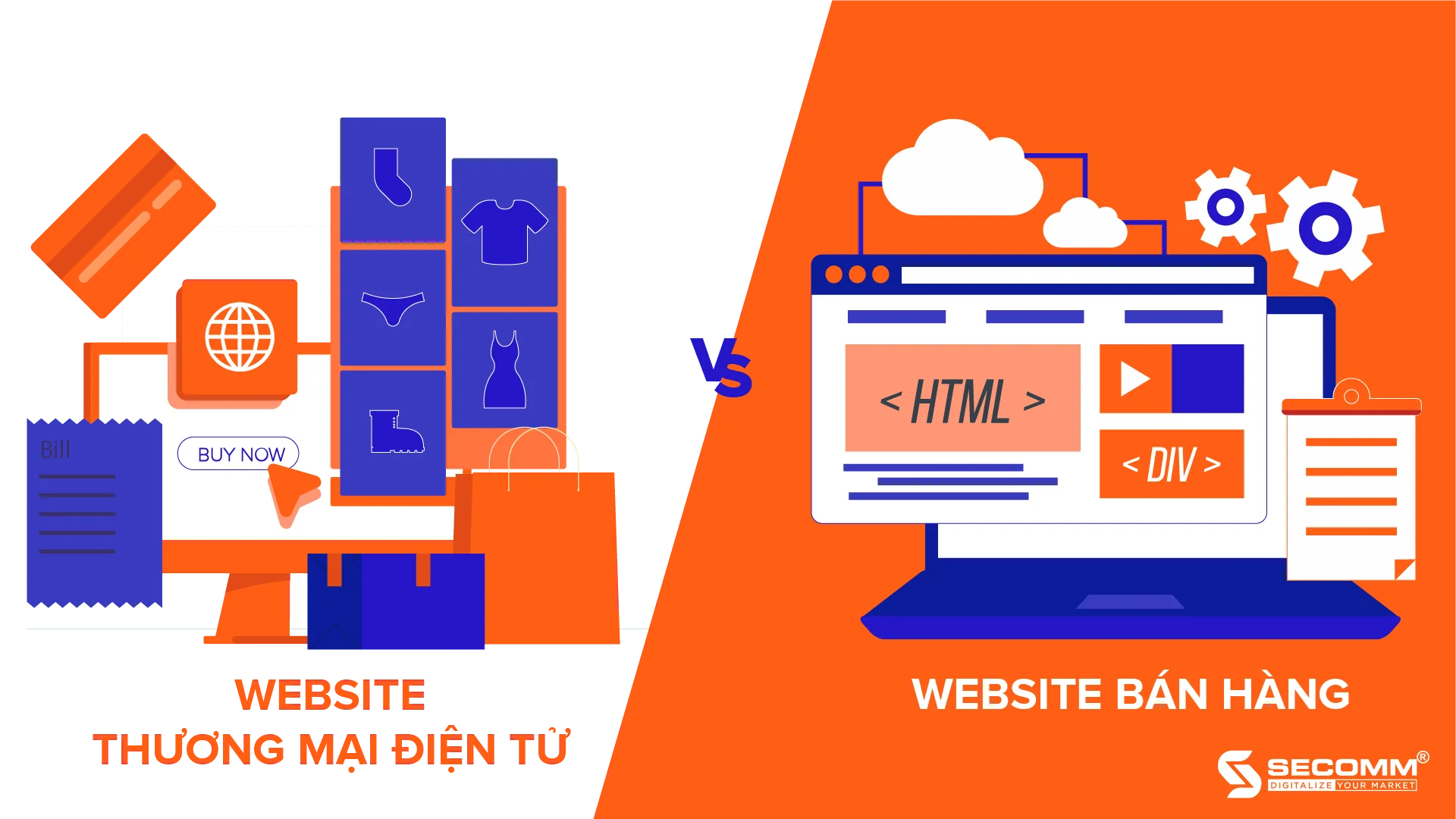
Ecommerce websites and online shopping websites both serve the purpose of buying and selling products and services online for businesses.
So:
An e-commerce website is established to serve the entire process of selling goods or providing services, from providing information and introducing the business, products or services, to supporting payment and post-purchase services. In particular, the payment feature on e-commerce websites is executed through multiple steps and follows certain standards. On the other hand, shopping websites mainly provide information about the store, business, or the products and services offered.

In terms of scale, e-commerce websites typically have a diverse range of product categories and services. In contrast, shopping websites usually only deal with a specific set of products or areas, so the scale is generally small to medium.
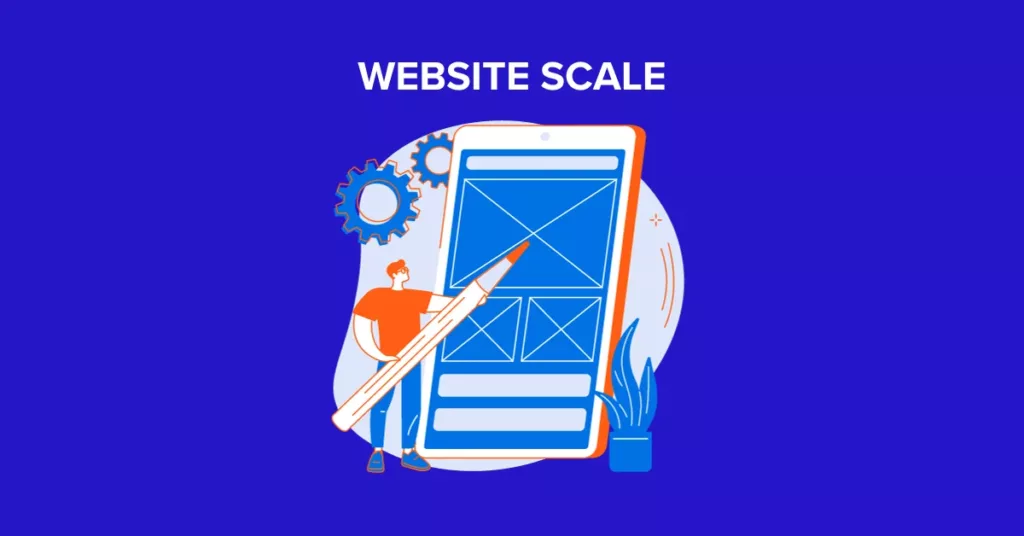
To present a variety of products, and services to customers, and support businesses in managing their online business systems, e-commerce websites need a complex back-end operating system (data access layer) with integrated functions such as customer management, product category management, analysis and reporting, SEO support, Ecommerce Marketing, Omni-channel (ecommerce platforms such as Shopee, Lazada, Tiki, Sendo; social networks such as Facebook, Zalo, Tiktok, Linkedin, and individual e-commerce websites…) online payment, and shipping services. In contrast to e-commerce websites, shopping websites primarily introduce businesses and products, so they do not require the integration of many supporting features.

The interface of ecommerce websites is usually focused on and designed meticulously with a standardized UI, UX. Not only eye-catching, professional, and impressive, the interface of ecommerce websites also needs to demonstrate the complex features underlying the system and provide an optimal online shopping experience for users. Shopping websites have a simple interface and operational functions because they focus on only one type of product or specific area.

With a professional interface and a complex feature system, the investment cost for designing e-commerce websites is generally higher than for shopping websites. Especially for websites with a diverse feature set, the costs can be even higher. Regarding shopping websites, the development cost is usually lower as they are developed from a simple platform and sometimes do not require much specialized knowledge.
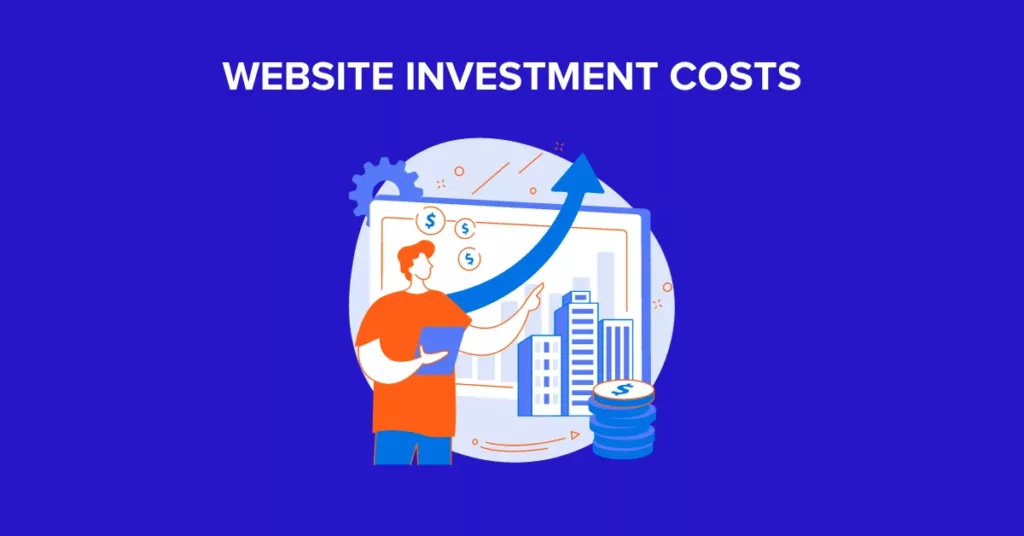
In summary, shopping websites are suitable for businesses that deal with a few products, services, or a specific industry group, do not require many complex features, and need to save website construction costs.
On the other hand, e-commerce websites are suitable for businesses with a diverse range of products and services, have the need to develop an ecommerce system for long-term business and budget savings, have specific growth goals, and have the financial capacity to enter the ecommerce market.
 2
2
 3,911
3,911
 0
0
 1
1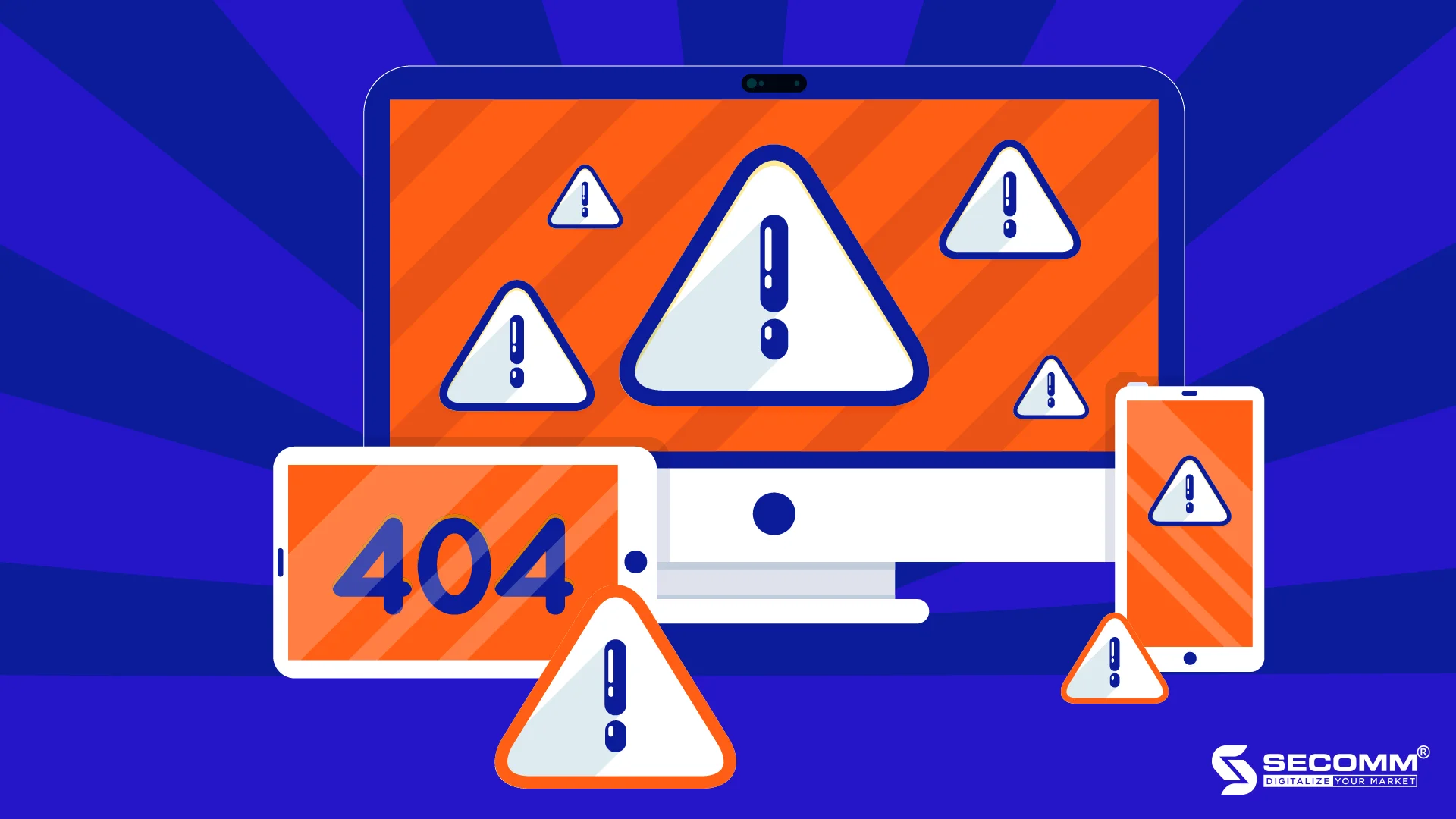
A website is a powerful tool for supporting ecommerce (Electronic Commerce) business, serving as a bridge between businesses and customers in the online shopping market, facilitating the entire process of buying and selling goods, and boosting sales. Therefore, building an ecommerce website is crucial for the ecommerce business of a company, requiring not only serious investment but also a long-term strategy.
However, there are still many ecommerce websites facing certain issues that need to be addressed promptly! Here are some common problems:
To evaluate the speed of a website, tools like Google PageSpeed Insights, WebPageTest, Pingdom Speed Test, Uptrends, etc., can be used.
Scores range from 0 to 100, where 0-49 indicates relatively low speed, 50-89 indicates average speed that needs improvement, and 90-100 indicates excellent speed.
Slow page load speed affects user experience, conversion rates, customer retention, and SEO ranking.
Causes:
Solutions:
Issues with graphic design, colour schemes, inconsistent images and fonts, lack of brand representation, and non-optimal website structure affect the professionalism of the interface.
Consequences:
Causes:
Solution:
Poorly structured product categories and incomplete product information negatively impact the user experience.
Issues:
Consequences:
Solutions:
Websites should support customer search, and provide convenient and quick shopping processes.
Issues:
Consequences:
Causes:
Solutions:
Failure to link sales channels (social media, ecommerce platforms, ecommerce websites) with internal business systems like CRM, and ERP for synchronization can lead to misinformation and management difficulties.
Issues:
Consequences:
Causes:
Solution:
 2
2
 4,492
4,492
 0
0
 1
1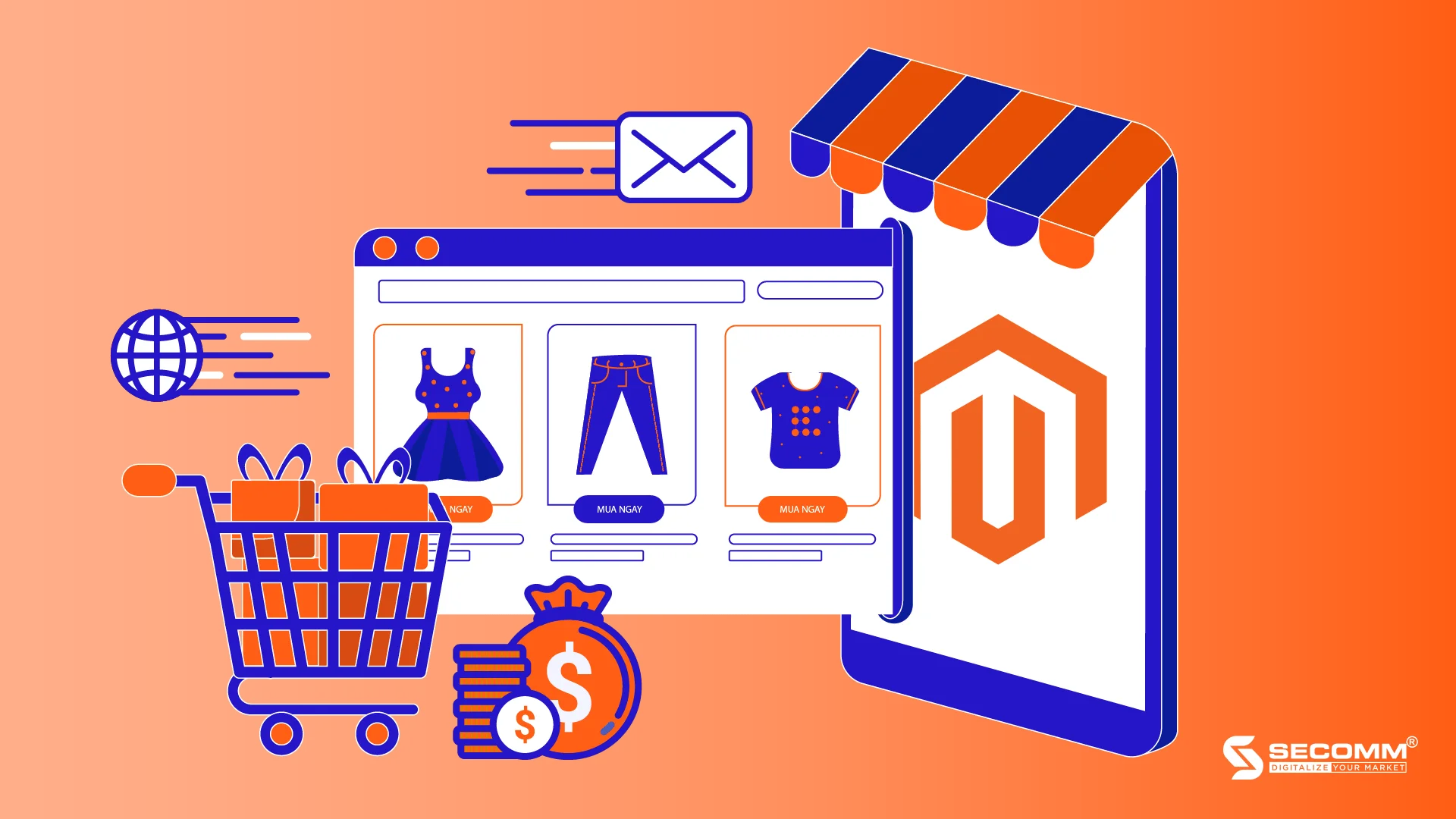
When deploying an ecommerce website, Magento is the top choice of platform that businesses are aiming for, including global giants like Nike, ASUS, HP, and Burger King, as well as leading Vietnamese enterprises such as Canifa, CellphoneS, Trung Nguyen, and CGV Vietnam.
With outstanding advantages ranging from a diverse ecosystem and flexible customisation capabilities to absolute security, Magento is considered the ‘ultimate boss’ among ecommerce website development platforms today.
So, what are the superior points of Magento?
Magento possesses all the features for a complete ecommerce website:
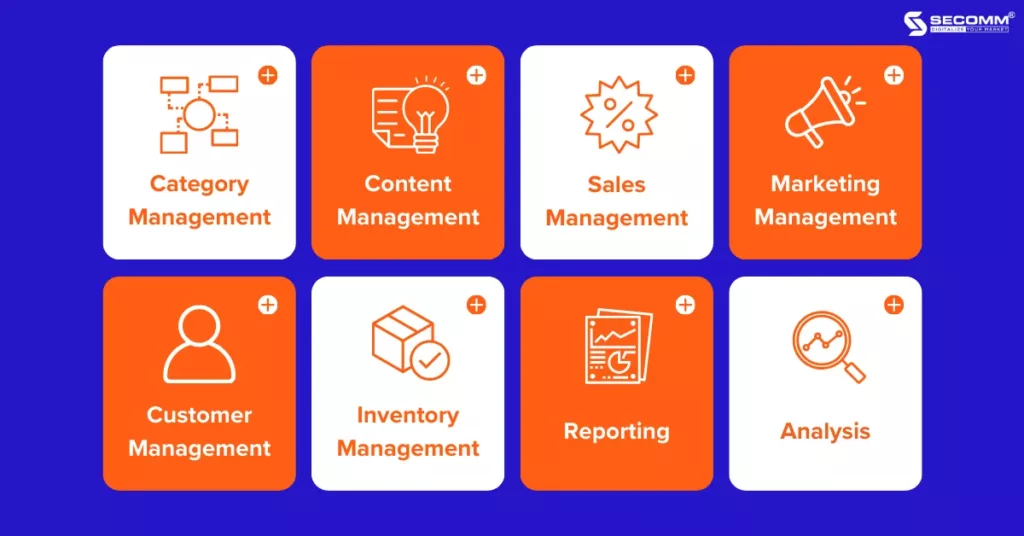
In addition to the basic features of a complete ecommerce website, Magento also owns a diverse system of extensions with many advanced functions in themes, products, marketing, optimal payment solutions, shipping, etc. to meet every operational need and ensure sustainable development of ecommerce for businesses.
When building an ecommerce website, Magento also supports businesses to integrate and link third-party services for efficient ecommerce website operation, such as:
Furthermore, Magento also has a global technical support community, including many rich experts and professional developers to meet all the requirements of businesses.
The Magento ecommerce website platform possesses all the advantages of open-source software with flexible customisation capabilities to operate the ecommerce website more effectively.
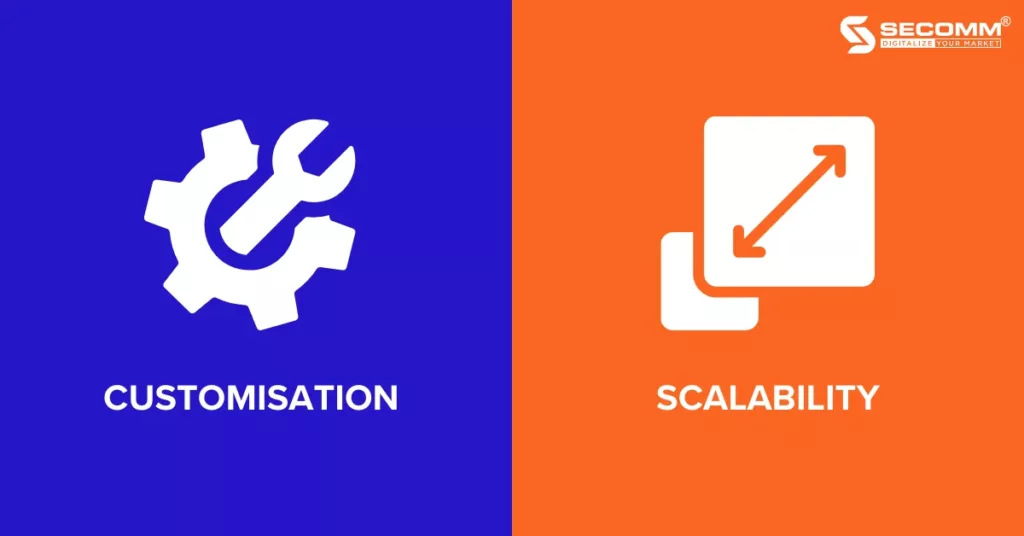
High security is also a superior advantage of Magento compared to other ecommerce website platforms, helping businesses minimise potential risks from data systems and transaction processes on the system.
Some outstanding points of Magento’s security features include:

With the advantages of having all ecommerce website functions, from basic to advanced, high customisation capabilities, and high security, Magento is the top choice for businesses when deploying an ecommerce website system. However, issues related to costs, time, and the requirement for a highly specialised technical team make it challenging for many businesses to implement an ecommerce website system with Magento.
Contact SECOMM now for FREE CONSULTATION SUPPORT!
 2
2
 3,901
3,901
 0
0
 1
1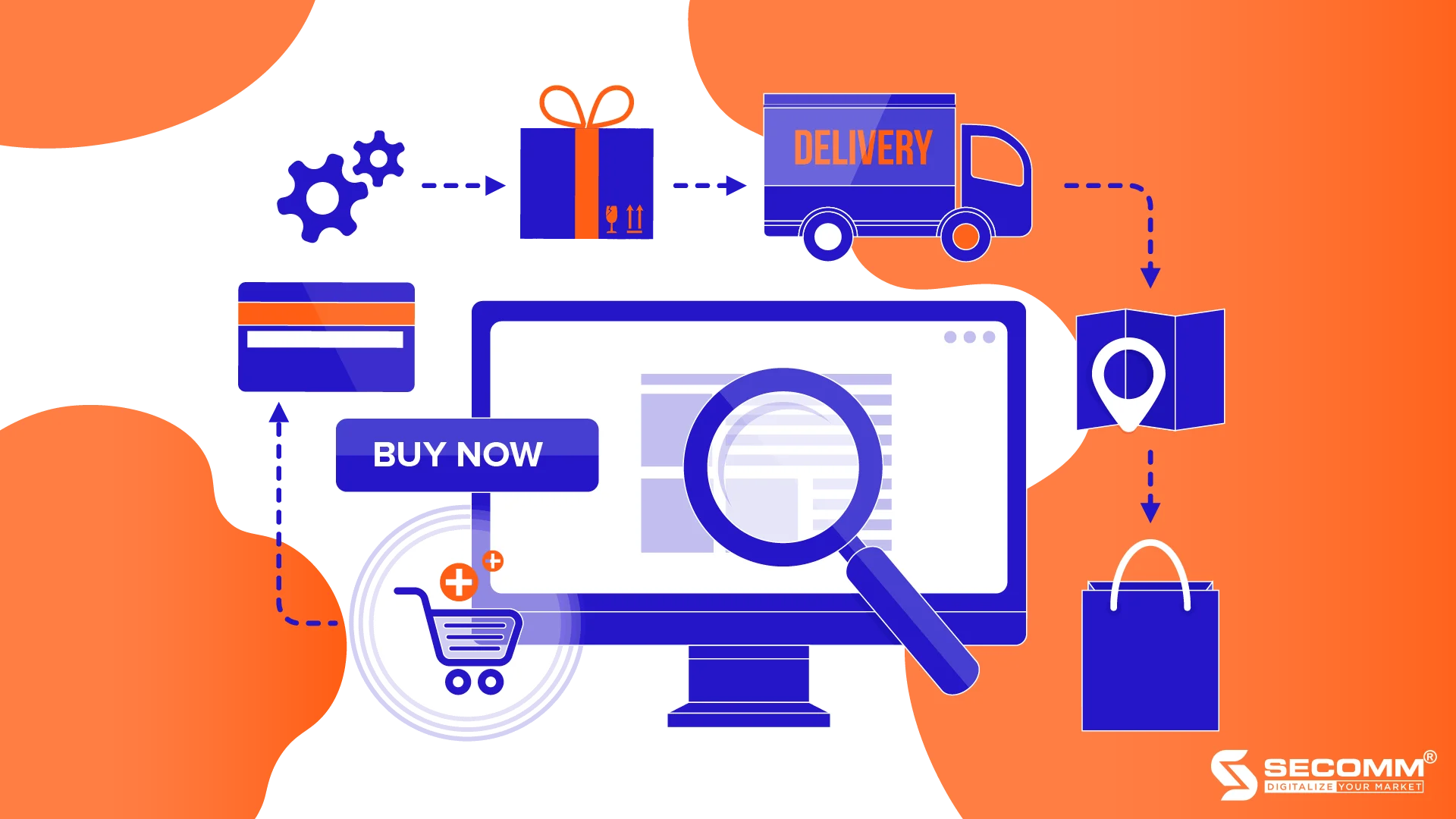
Frequent monitoring of metrics in business allows a deeper understanding of customers and quantifies important aspects of the business. Particularly in ecommerce (Electronic Commerce), measuring these indices is even more crucial as they assist businesses in assessing existing risks and opportunities in the market.
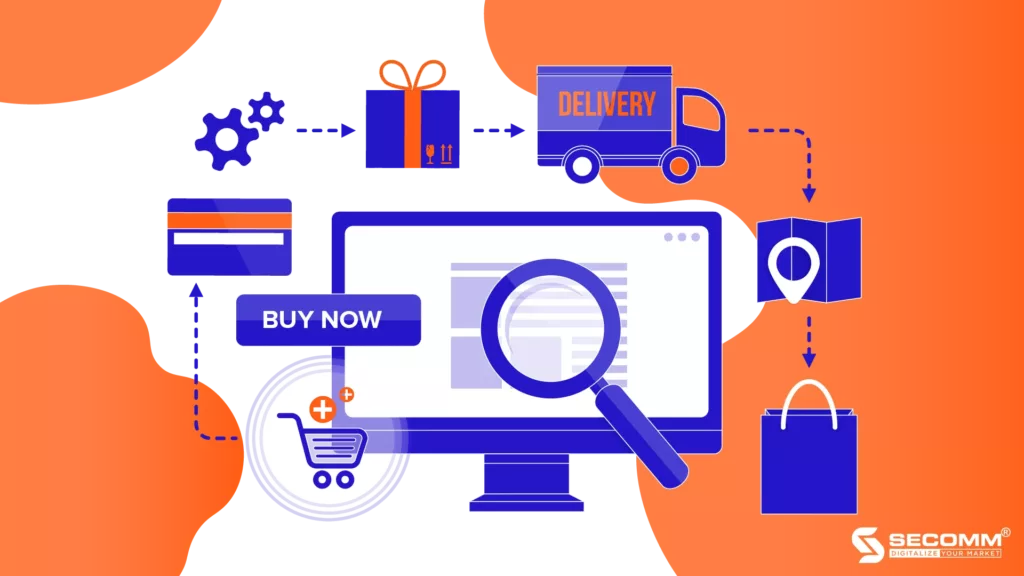
Indicates how much profit is generated for every dollar of revenue.
Formula: Gross Profit Ratio (%) = Gross Profit / Revenue
The value of goods sold or consumed during a specific period.
Formula: Cost of Goods Sold = Beginning Inventory + Additional Purchases During the Period – Ending Inventory
The average amount a customer spends when shopping on an ecommerce website.
Formula: Average Order Value = Revenue / Number of Orders
Average revenue based on the conversion rate each time a customer visits an ecommerce website.
Formula: Revenue Per Click = Revenue / Number of Visits
The value a customer contributes to a company over their entire lifetime.
Formula: Customer Lifetime Value = (Transaction 1 + Transaction 2 + Transaction 3 + …Transaction n) x Average Profit Margin
Indicates the average number of times a customer purchases within a specific period.
Formula: Purchase Frequency = Total Orders / Total Customers
Measures the time between consecutive purchases by a customer.
Formula: Time Between Purchases = Purchase Frequency / 365
Measures the number of customers who added items to their cart but did not complete the purchase.
Formula: Cart Abandonment Rate = 1 – (Completed Transactions / Carts with Products) x 100
The cost associated with persuading consumers to purchase a company’s products or services.
Formula: Cost of Acquiring Customer = Total Cost / Number of New Customers
Indicates the likelihood of customers returning to make a second or subsequent purchase.
Formula: Repeat Purchase Rate = Number of Repeat Purchases / Total Number of Purchases
Refers to the total number of visits to an ecommerce website.
Identifies the primary sources directing traffic to your website.
Indicates the average time a visitor spends on the website.
The average time users spend in a single session.
Formula: Total Session Duration / Number of Sessions
Measures the level of content engagement, indicating how deeply users explore information on the website.
Formula: Pages per Visit = Number of Pages Viewed / Visits
The percentage of single-page visits where visitors leave without clicking on any other content.
Formula: Bounce Rate = Total Bounces in a Period / Total Visits in that Period
The rate at which customers view and click on a business’s advertisements.
Formula: Click Through Rate = Number of Clicks / Number of Impressions
Indicates the number of people who interacted with a company’s content through various ecommerce channels such as the business’s ecommerce website/app, ecommerce platforms, Facebook, Instagram, TikTok, etc.
Formula: Social Media Engagement = Number of Interactions / Number of Followers
The Internet marketing model is where businesses pay a fee each time their ads are clicked.
Formula: Pay-Per-Click Cost = Advertising Cost / Number of Clicks
Measures the ratio of potential customers who become actual customers by making a purchase.
Formula: Conversion Rate = Number of Conversions / Total Ad Interactions
 2
2
 11,773
11,773
 0
0
 1
1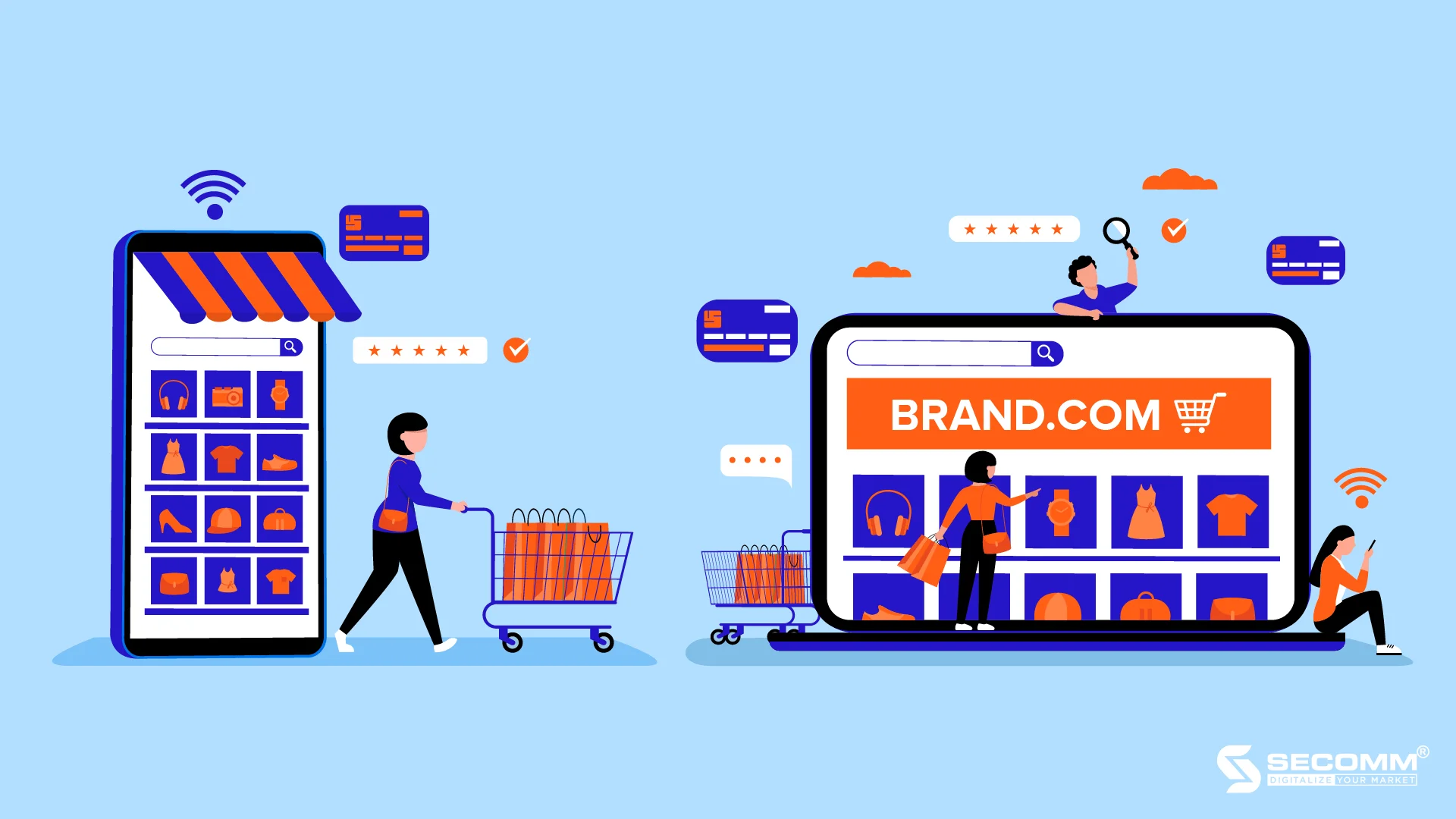
Branding plays a crucial role for businesses, especially in the e-commerce market. An effectively built brand in the e-commerce market helps customers recognize and favor the brand, leading to a tendency to shop on e-commerce websites and become loyal customers in the long run. Building a brand on an e-commerce website is the key to sustainable growth for businesses in this market.
Here are 10 prominent trends in building brands on e-commerce websites applied during the current ‘new normal’ era!
One of the most important tasks for any business during development is to establish a unique style for the brand, especially on e-commerce websites. …Creating an impression in the consumer’s mind helps customers distinguish the brand’s products from competitors. Simultaneously, establishing a unique style creates consistency across all products/services that the e-commerce website provides.
Mobile World Investment Corporation (MWG) has designed a logo and layout with characteristic imagery and uniformity across all e-commerce websites of its brand chain, such as The Gioi Di Dong, Dien May Xanh, Bach Hoa Xanh, Nha Thuoc An Khang. This helps customers of one of the four brands to recall the other brands within MWG.
Brand storytelling is a method to attract customer attention to a brand through the brand’s origin story and promoting the brand’s mission and vision. Sharing brand stories on e-commerce websites helps businesses create a connection to customers’ awareness.
With the goal of creating a brand image through storytelling, the ‘Coolmate Story’ section on the e-commerce website is built based on its name ‘Coolmate,’ with ‘cool’ symbolizing the cool, dynamic appearance of men and ‘mate’ symbolizing the brand’s mission – to be a companion in men’s fashion. Building a story about a fashion brand for men has made Coolmate’s e-commerce website a popular online shopping destination for young male customers in Vietnam.
The trend of building a “made-in” Vietnam brand is not unfamiliar to customers, from supermarkets with the motto “Vietnamese people use Vietnamese products” to the branding method of “Proudly Vietnamese Brand” appearing on e-commerce websites of Vietnamese brands such as Vinfast, Gumac, Highlands Coffee, etc. … Eliciting pride in the Vietnamese nation and calling for support from customers.
The branding strategies of Biti’s, especially for the Biti’s Hunter product line, are always closely associated with the “made-in-Vietnam” message. When launching the online store https://bitis.com.vn, Bitis also subtly incorporates national elements into every corner of the website, such as images, product information, banners, and blog posts.
Brand positioning associated with community benefits, such as supporting charities, donations, non-profit sales, or becoming a brand that encourages support… Building a brand through charitable activities helps enhance the company’s image in the eyes of consumers, promoting online shopping support on the brand’s e-commerce website.
Vinamilk is always a pioneer in social responsibility activities. Vinamilk has established several community funds to support activities to improve nutritional knowledge, healthcare, and improve clean living environments for surrounding communities, such as the School Milk Program (since 2006), the Vietnam Tall Milk Fund, the 1 Million Green Trees Fund for Vietnam. These messages are consistently conveyed on the company’s website.
By designing the brand or product lines displayed on e-commerce websites in line with the environmental protection trend, brands can increase public and potential customer sentiment.
Cocoon, a cosmetics brand from Vietnam, has successfully built the “Eco-Friendly” brand image on the current e-commerce market. The “Eco-Friendly” element of Cocoon is immediately shown in the website’s title tag as 100% vegetarian cosmetics. The content on the website consistently emphasizes the brand’s direction of environmentally friendly cosmetics, sourced from natural ingredients, not tested on animals, and certified by international organizations. Thanks to this, Cocoon has successfully positioned the “Eco-Friendly” brand in the hearts of Vietnamese beauty and nature lovers.
This is a new trend that helps brands maintain their values but adapt their business direction to fit the new normal period, such as:
F&B shifting to cloud kitchens, Travel companies offering touchless and virtual tours…
Changing business models have breathed new life into brands, creating a transformation for the brand. This stimulates curiosity about the brand’s changes among customers.
National Geographic – U.S. National Geographic Society has developed a virtual tour of Vietnam’s Son Doong Cave on its website, combining augmented reality (AR) virtual reality (VR) technology. This achievement not only contributes to the attractiveness of Son Doong Cave but also enhances the brand position for National Geographic, becoming a case study for many famous travel websites about virtual tours.
Consumers today are becoming more discerning and will not easily accept low-quality products on the e-commerce market.
Building a brand that focuses on a few high-quality products on the e-commerce website can make customers loyal to the brand and enhance the brand’s reputation.
3 Sach Food, a brand that focuses on providing clean, chemical-free, non-stimulant, and preservative-free products, has successfully attracted a group of customers interested in the quality of food. Thanks to the focus on product quality, 3 Sach Food has successfully attracted the attention of customers interested in food quality.
Content contributes to developing the relationship between the brand and customers.
Building content with the potential to spread among customer groups will help the brand establish a faster image in the eyes of consumers.
With the goal of building viral content, CellphoneS focuses on updating dramas, hot news, reaction videos, etc., to attract the attention of the youth on the blog website and cleverly embeds technology products, encouraging shopping activities.
To connect emotionally with customers, businesses need to speak their language.
Responding to customers in the language they use for communication will help them react more quickly to brand marketing campaigns and contribute to leaving a more positive impression after brand-building efforts.
Durex, dubbed the ‘content saint’ in the marketing world, always impresses people with its ability to creatively create content using customer language even on the e-commerce website. Applying customer language not only helps the brand increase sales growth but also becomes a companion in every ‘love affair’ of customers.
Brand positioning through digital brand experiences, integrating automation, AI, and virtual reality VR, is considered a new trend for ecommerce businesses. Increasing touchpoints for the brand on e-commerce websites through enhancing the customer experience.
Fitin provides a completely new furniture shopping solution for customers on the e-commerce website and mobile app by integrating 3D technology: VR, AR, Homestyler. Thanks to this, customers not only experience new, professional shopping but also contribute to affirming the position of the Fitin brand in the furniture industry in the eyes of consumers.
Doing ecommerce business in Vietnam is undoubtedly a long-term game for any business entering this market. To develop sustainably, building a brand on e-commerce websites is a prerequisite that cannot be ignored. However, building a brand on eCommerce websites is still a relatively new story for many businesses in Vietnam.
To inquire about free consultation on eCommerce solutions, please contact SECOMM for expert advice.
 2
2
 5,553
5,553
 0
0
 1
1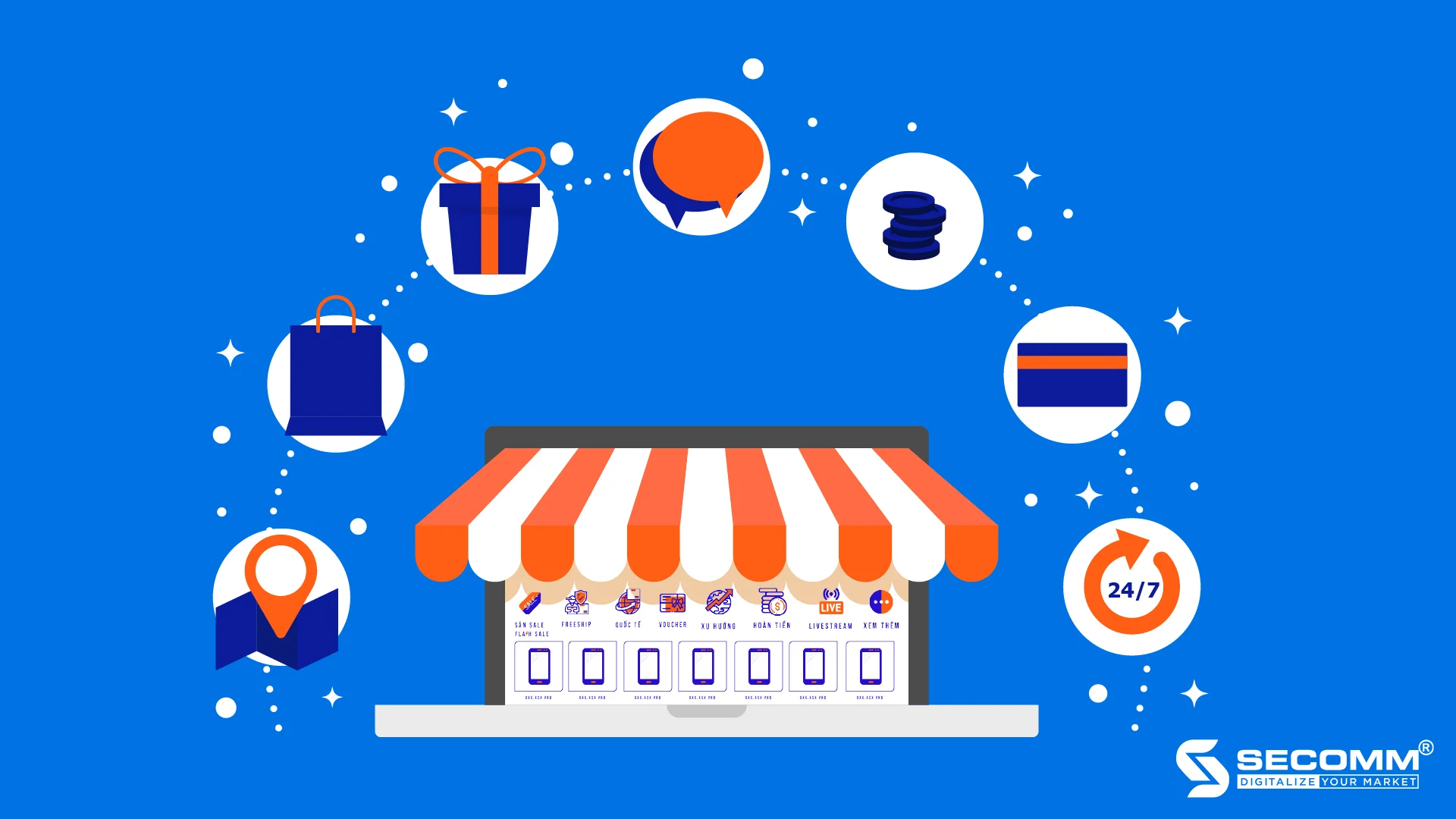
As consumer shopping trends shift from offline to online, owning an ecommerce website (EC) is almost a prerequisite for successful business operations. Despite its importance, many businesses are still unsure where to start to build an effective EC website.
Here is a step-by-step journey to building an EC website from basic to advanced for businesses to refer to!
When entering the ecommerce market, businesses often build a basic-level ecommerce website to minimize time and budget for website development and gradually adapt to market changes.

Businesses can use free website-building tools with ready-made interfaces and features to create a website through simple drag-and-drop operations, without investing too much time and budget in website development and programming. Some popular platforms include Sapo, Haravan, Nhanh.web.
Advantages
Reasonable initial deployment costs with a contract based on usage time.
Disadvantages
Businesses use ready-made templates on the platform and customize them to fit the brand image, industry, and consumer preferences. The chosen platforms offer basic features, and businesses only need to select suitable functions and set them up on the website.
According to Government Decree 52/2013/ND-CP, individuals or organizations that own ecommerce websites for selling goods must notify or register with the Ministry of Industry and Trade on the Ecommerce Management Information Portal.
After using a basic ecommerce website for some time, businesses gradually realize the need to develop an independent, in-depth, and uniquely designed ecommerce website to promote a sustainable ecommerce journey.
Developing a specialized ecommerce website requires both experience and substantial investment in costs and time. However, this is a cost-effective solution for long-term business plans and a suitable transition for a separate and comprehensive ecommerce system.
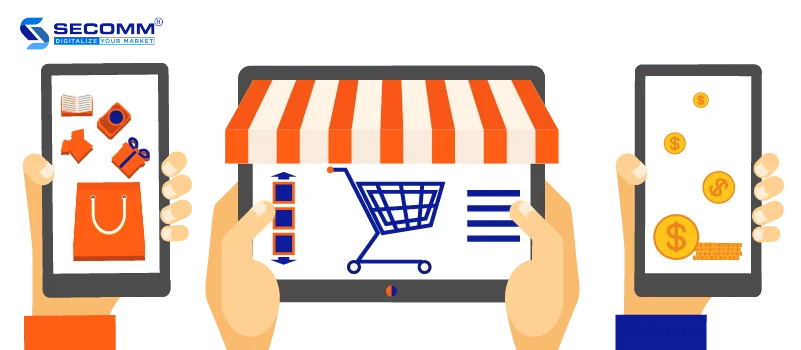
At this stage, businesses can choose specialized e-commerce platforms like WooCommerce, BigCommerce, Magento, which are scalable and customizable to maximize the requirements of:
However, implementing a specialized e-commerce website may face some difficulties:
When building an ecommerce website on specialized platforms, as it requires time, costs, and high expertise, businesses often collaborate with service providers for ecommerce website development. Afterward, businesses can build an in-house team or continue working with the provider to maintain website operations.
Some service providers for deploying specialized ecommerce systems include SECOMM, SmartOSC, Co-well Asia, Isobar, Magenest.
During project deployment based on the agreed solution with the development provider, all factors related to the quality and effectiveness of the website need to be optimized and tested before handover. Especially crucial functions include:
To maintain seamless online-to-offline business operations, the website needs continuous maintenance, care, and updates.
Implement activities to increase sales operations on the website and stimulate online sales.
The journey from building a basic to an advanced ecommerce website helps businesses adapt to market changes over time.
 2
2
 4,524
4,524
 0
0
 1
1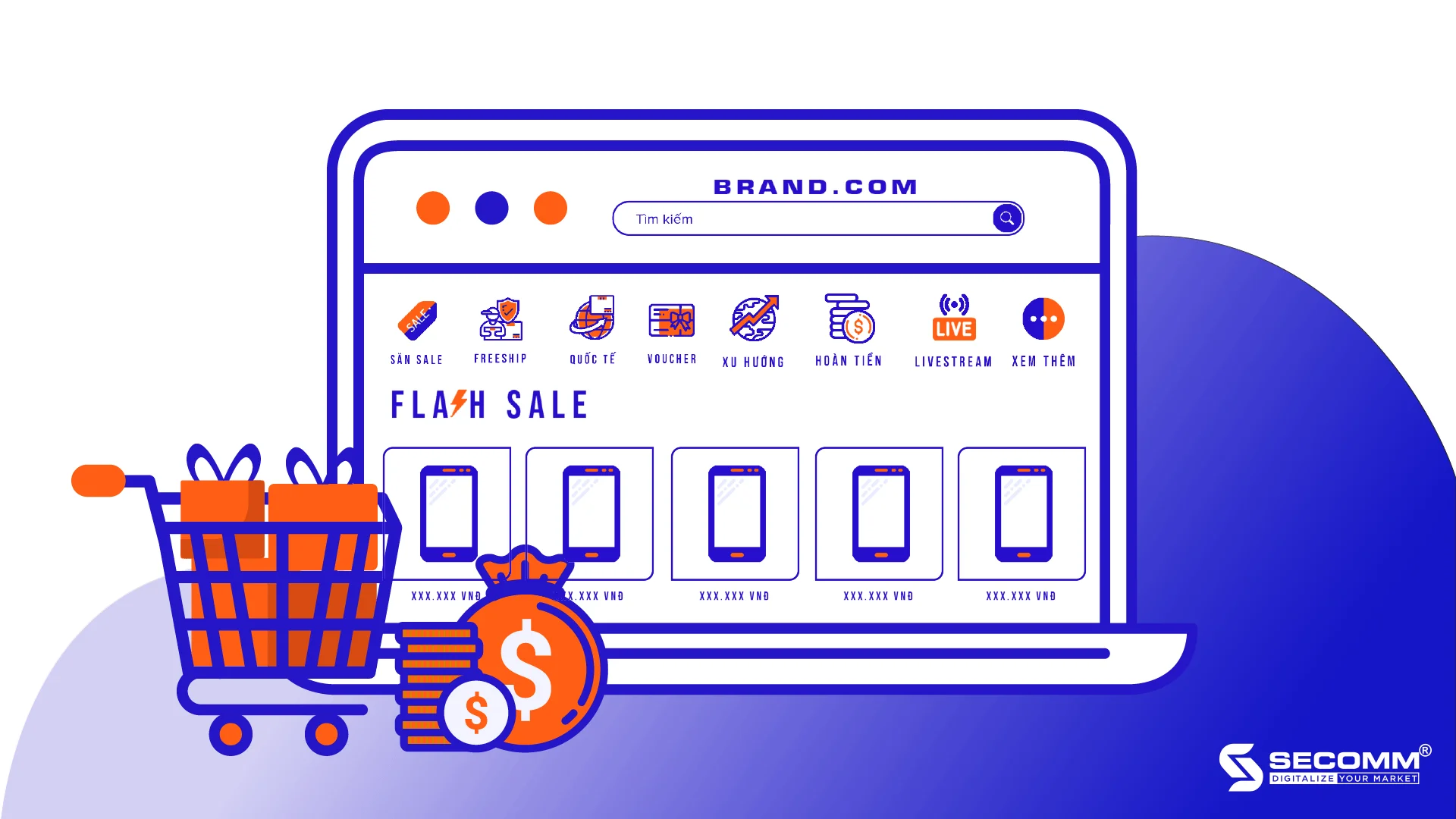
Ecommerce website has been a companion for businesses facing COVID-19 challenges in 2020-2021. Efficient utilization of ecommerce (EC) not only helps businesses adapt to changing user and market dynamics but also enables them to seize opportunities and excel in the fiercely competitive landscape. Some successful standalone EC websites include thegioididong.com, bachhoaxanh.com, and fptshop.com.vn.
What is the formula for the success of these businesses?
This success hinges on the ability to have a broad vision and a strategic approach at the management level. Building a dedicated EC website is not just about establishing offline stores; it involves developing and optimizing an EC system that aligns with the business, brand, and users. Building a successful brand website offers various benefits, from brand positioning, cost savings, maximizing revenue to owning all data and controlling the game.
A dedicated EC website serves as a medium to convey the brand image and connects businesses with customers in the online market. By owning a dedicated EC website, businesses can easily convey messages, establish specialized marketing campaigns, provide accurate information, and promote the brand to get closer to customers.
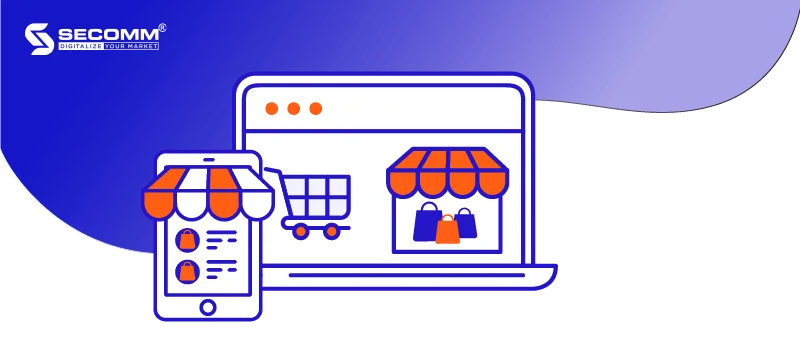
Operating on a website, businesses are not limited by time and space. Business transactions can occur 24/7, regardless of location. Actively updating and upgrading the system’s features based on user characteristics, business needs, and industry specifics ensures an optimal user experience and facilitates a more convenient and faster purchasing process.
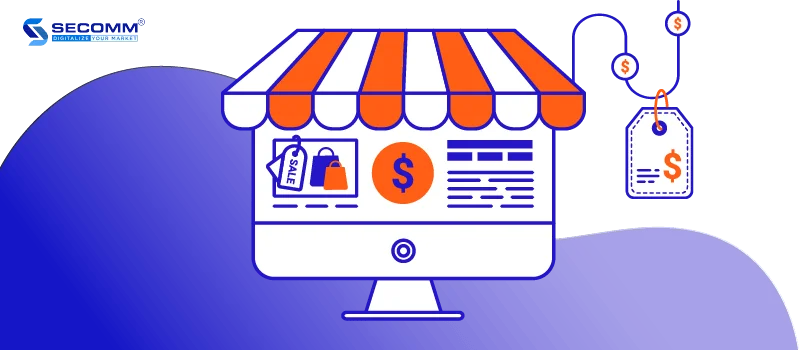
In addition to enabling direct access and sales to customers, eliminating intermediary costs, establishing an online store (brand.com) is an optimal solution for minimizing various expenses such as rent, personnel, and equipment. Moreover, the automated business process with E-Payment, E-Logistic, E-Invoice functions on the website helps save costs related to personnel and paperwork.

Building a dedicated EC website means owning a unique “playing field,” reducing dependence on data from EC platforms, social media, or other business systems. With this data, businesses can conduct in-depth data analysis, make business predictions, and develop appropriate directions for the business.
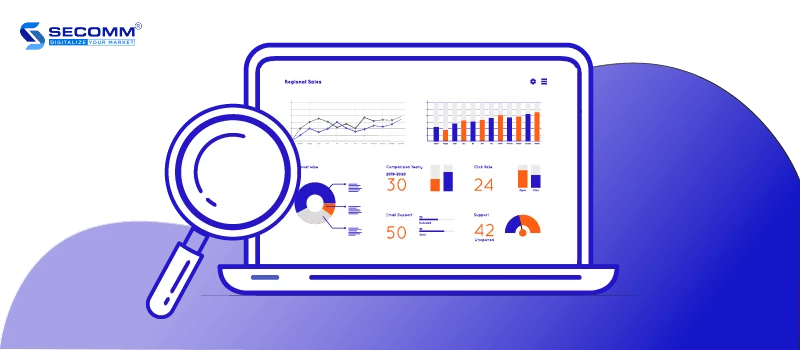
With these superior benefits of deploying a standalone EC website, many businesses have quickly embarked on building an online store for their brand. However, to truly own a successful website that meets specific requirements, similar to Vinamilk, Thế giới di động, Canifa, businesses need a suitable strategy and significant time and investment.
With extensive experience in building numerous standalone ecommerce websites for businesses across various sectors, SECOMM fully understands the challenges encountered during the e-commerce deployment process that businesses are facing.
Contact SECOMM to receive consultation on building your own ecommerce website!
 2
2
 3,353
3,353
 0
0
 1
1Subscribe to get the latest eBook!
Hotline